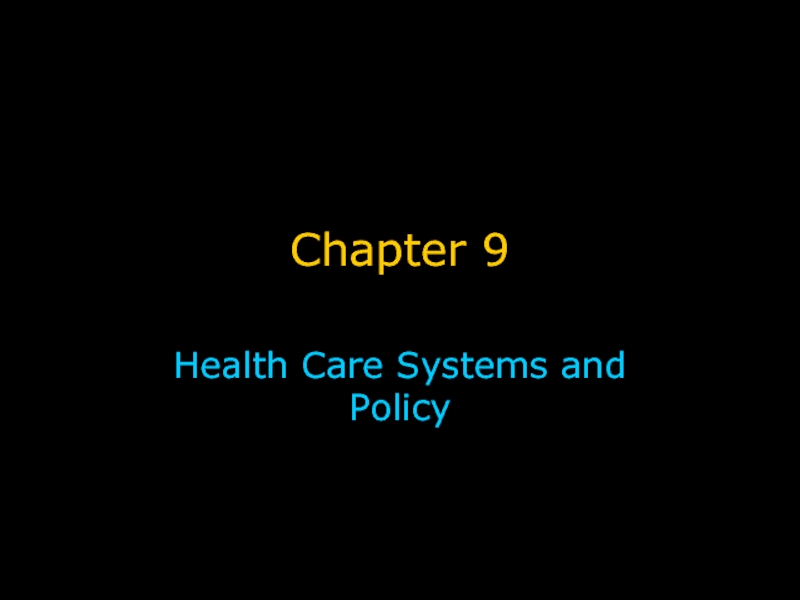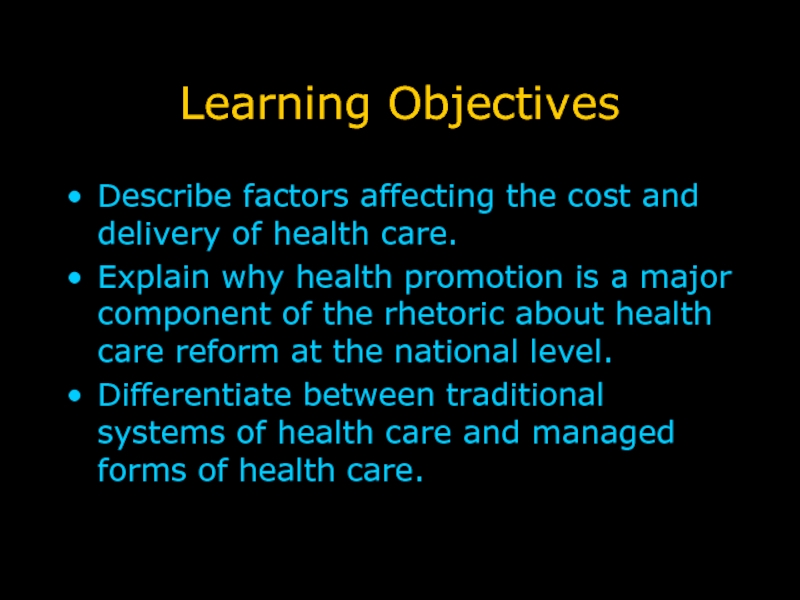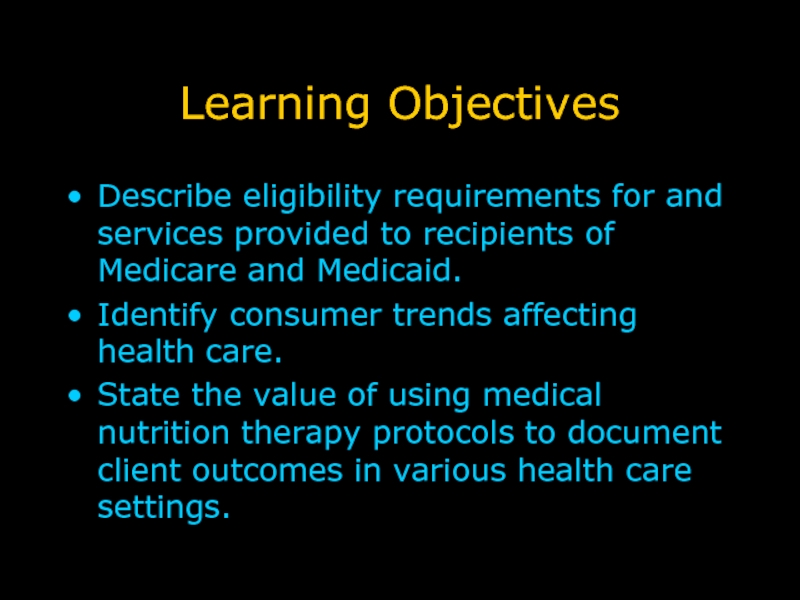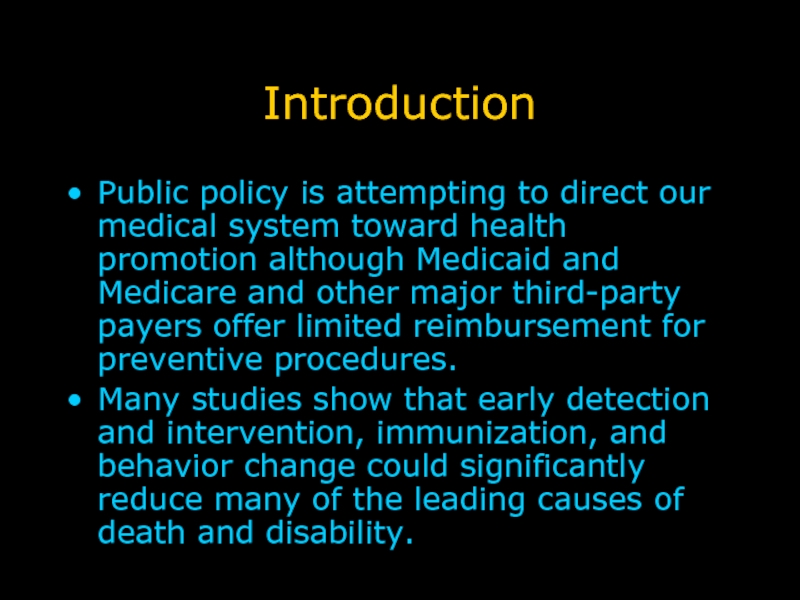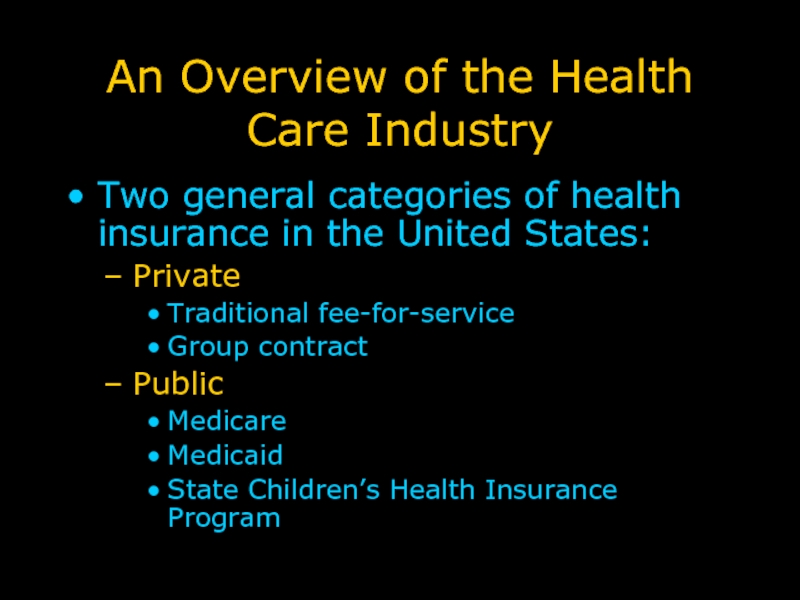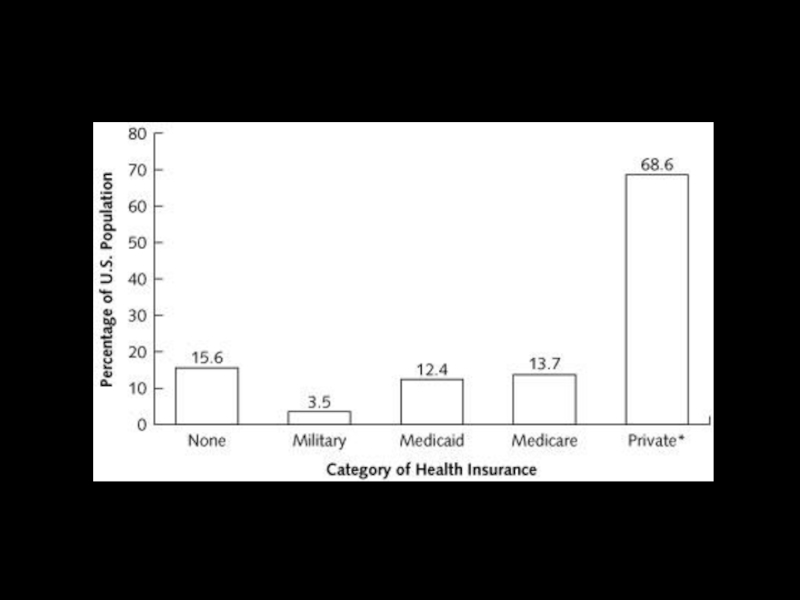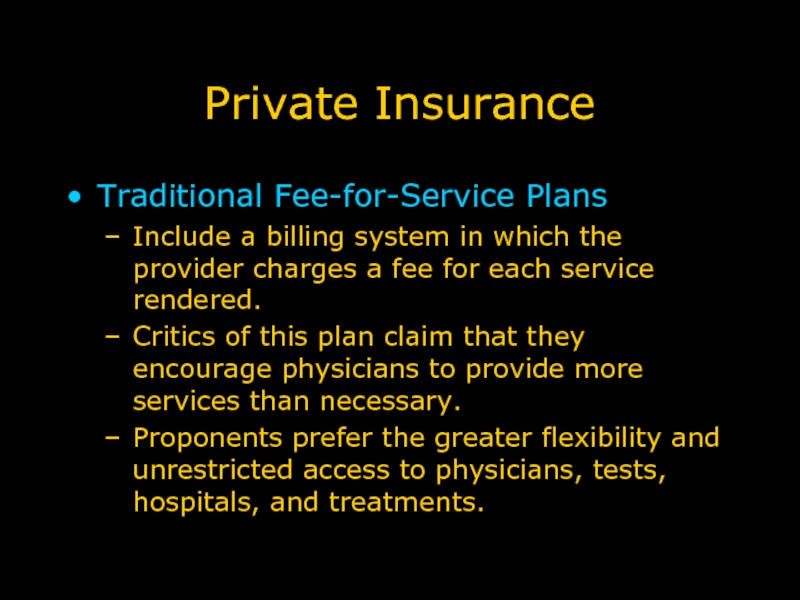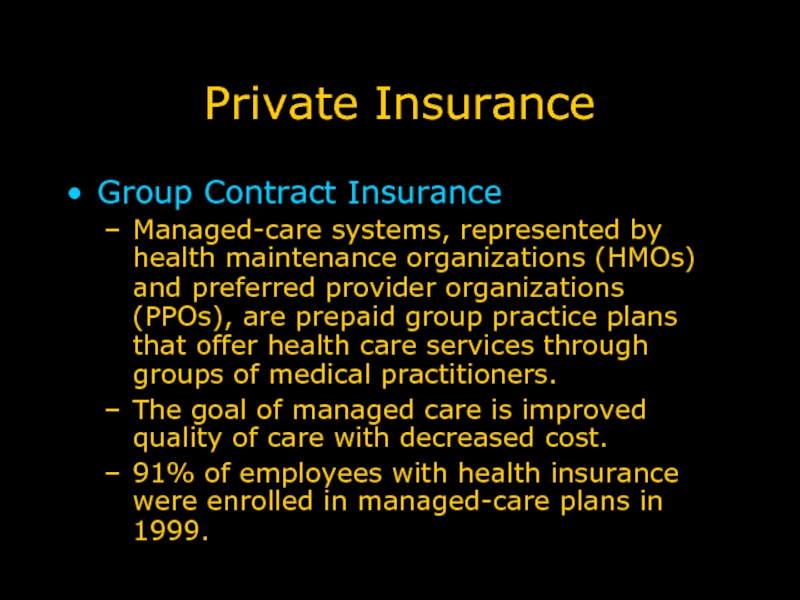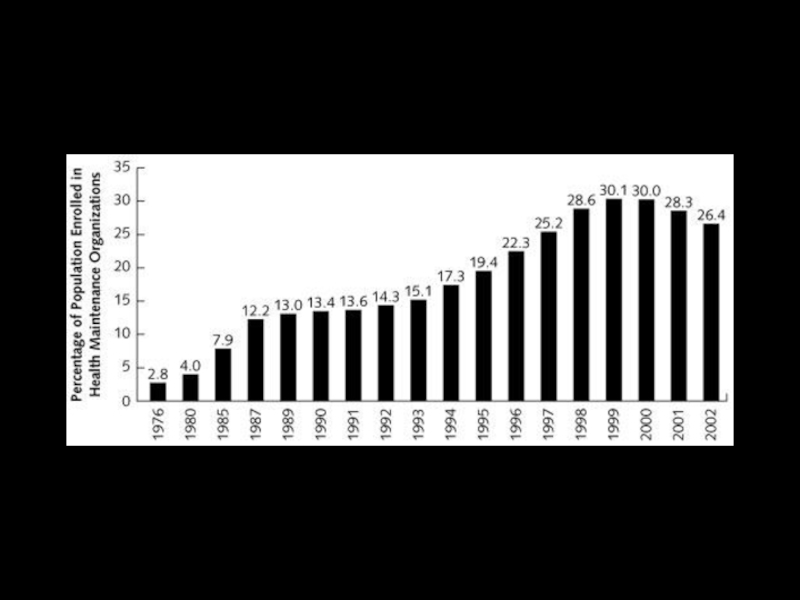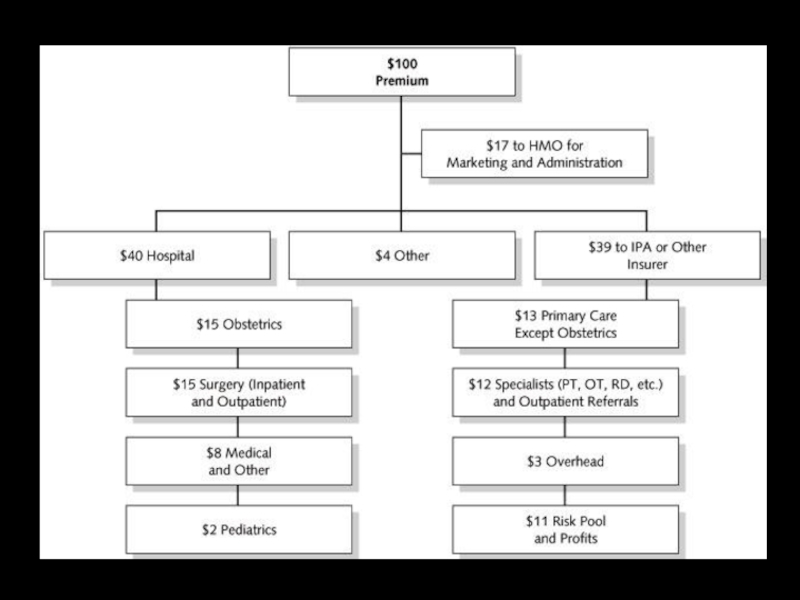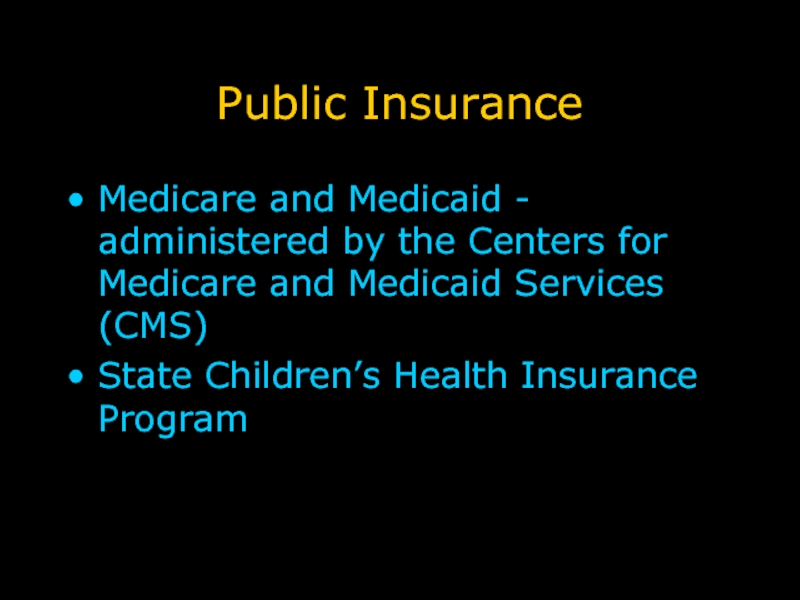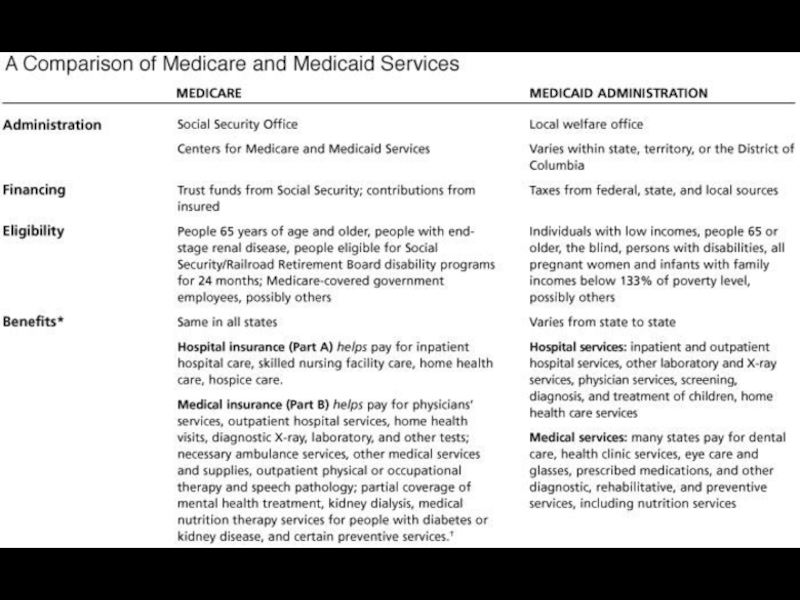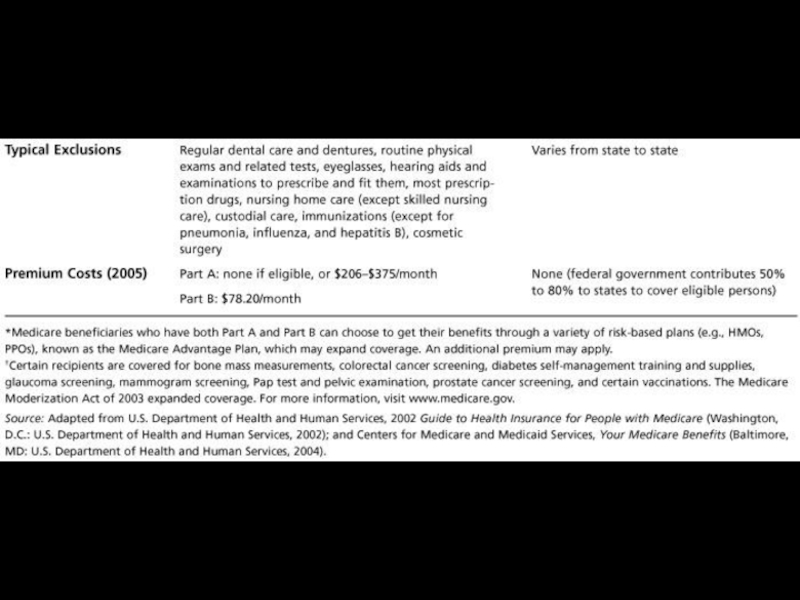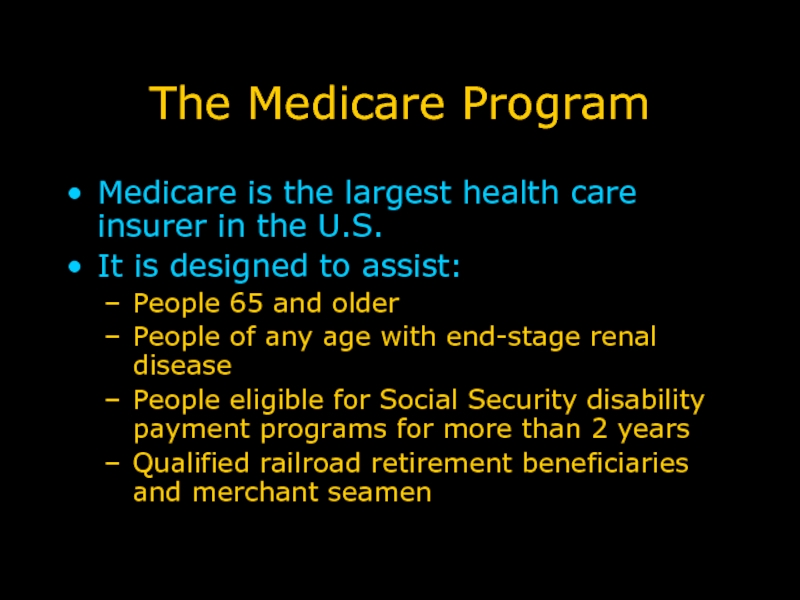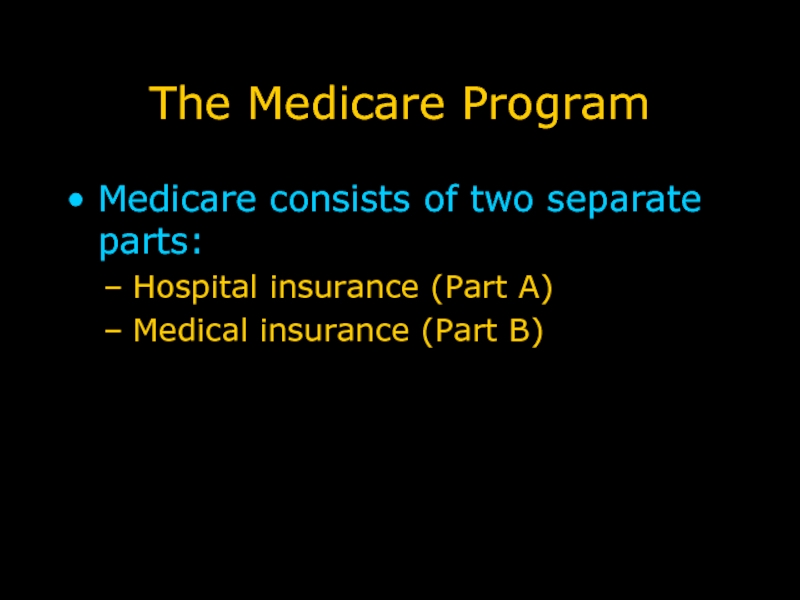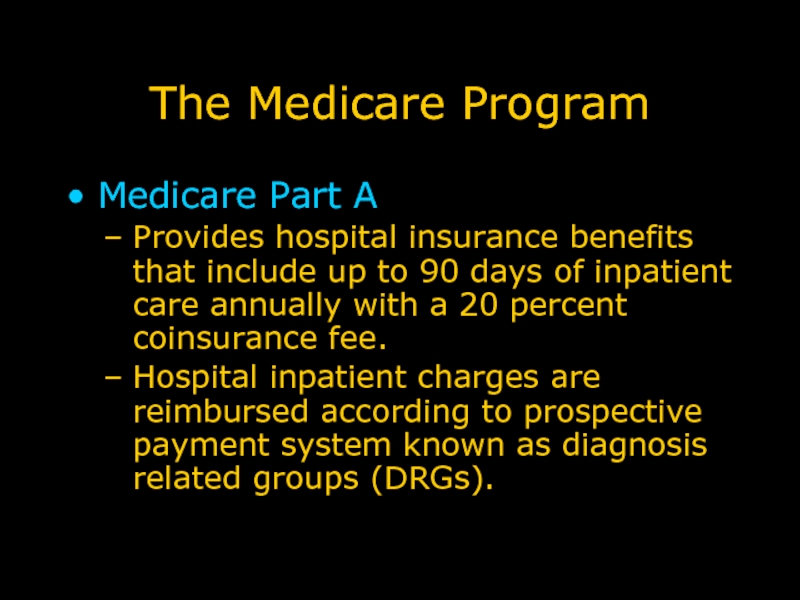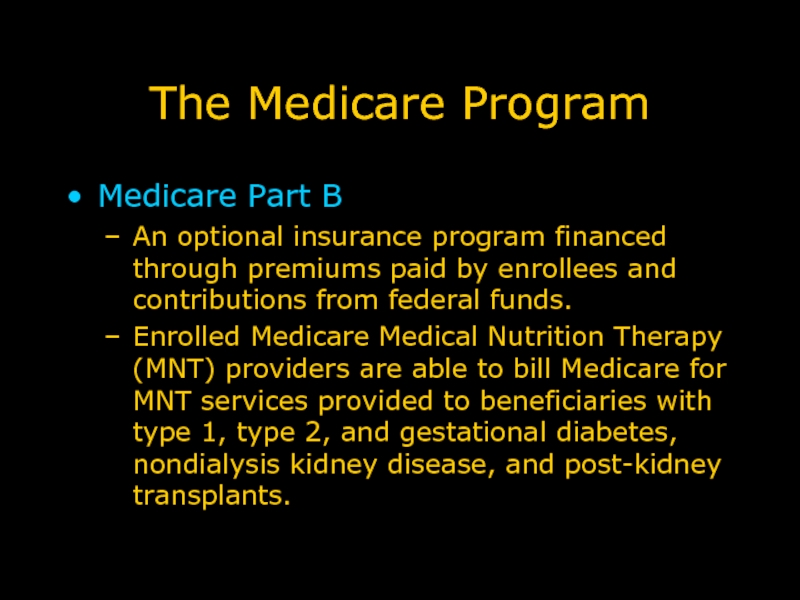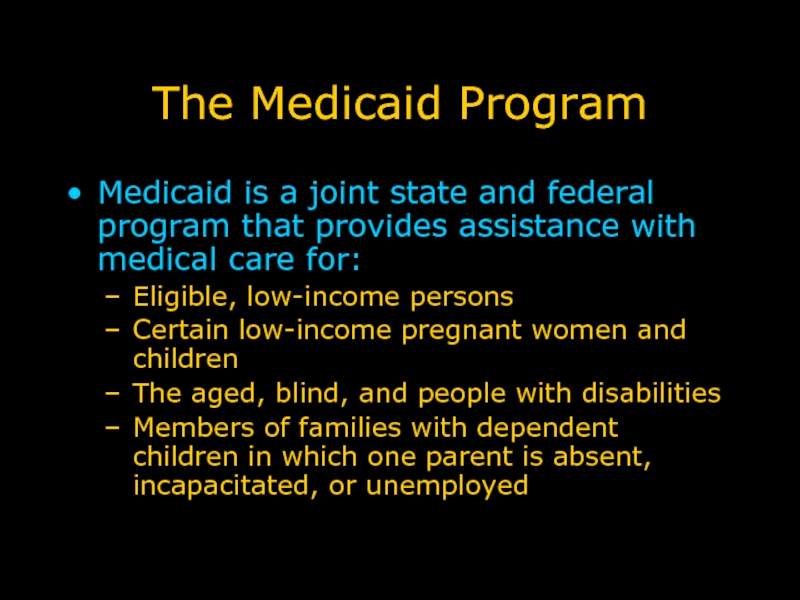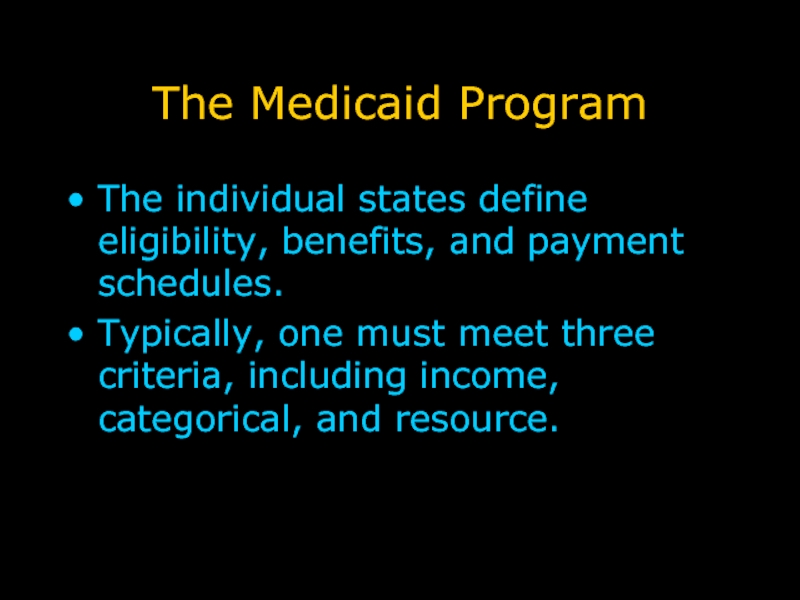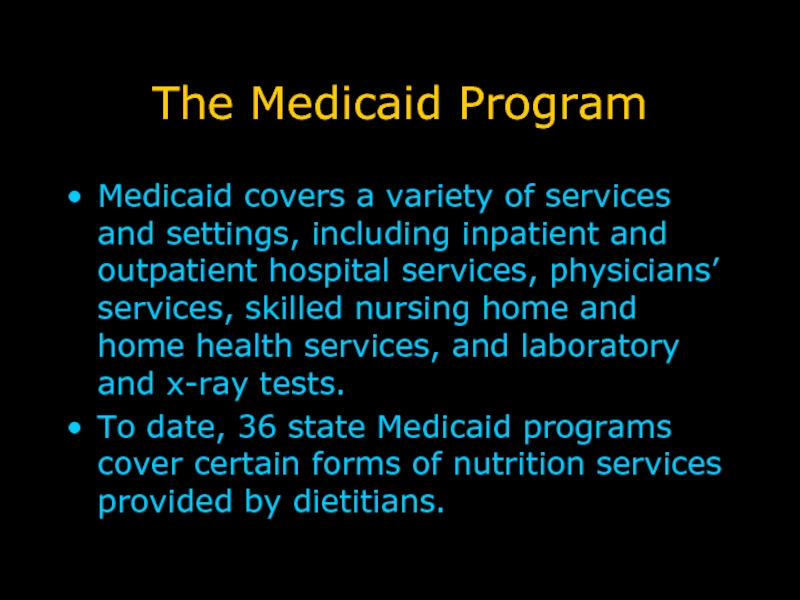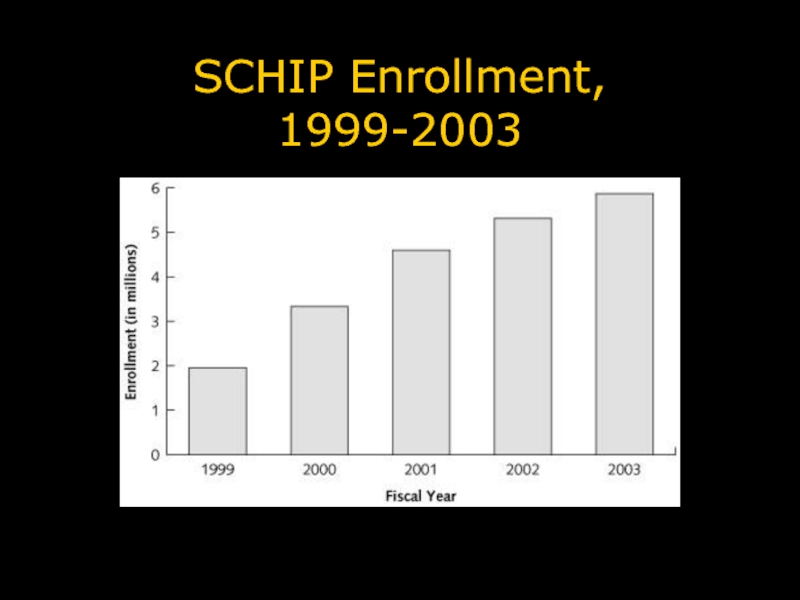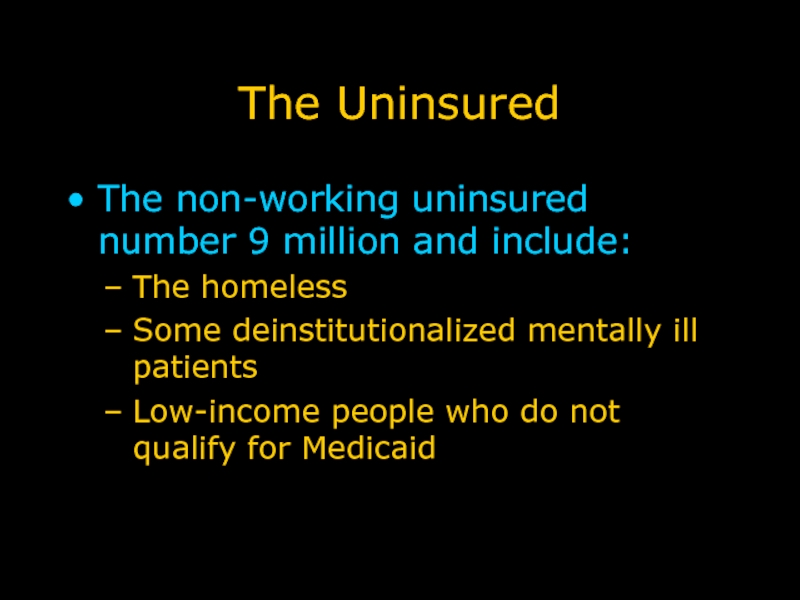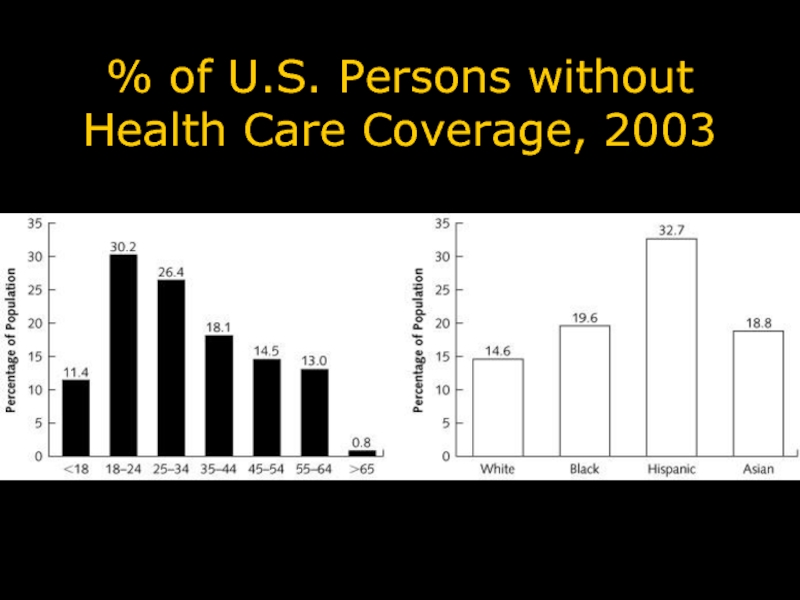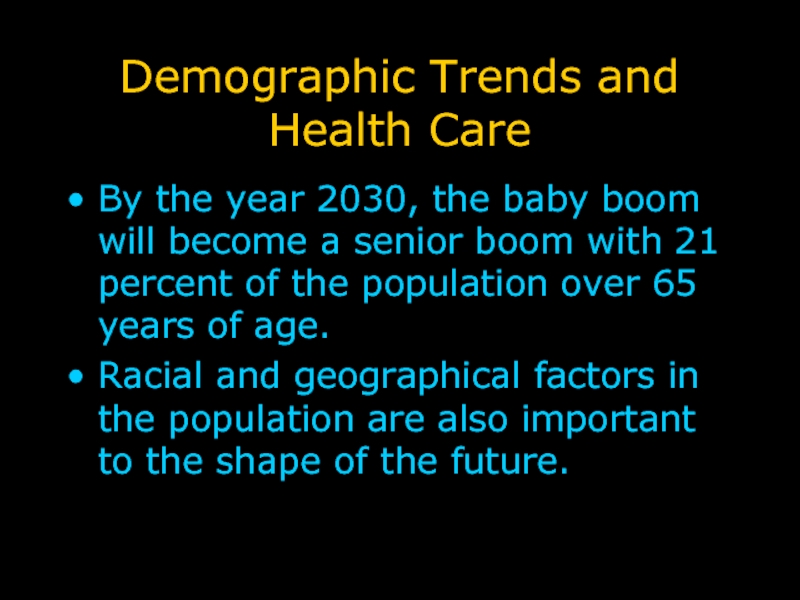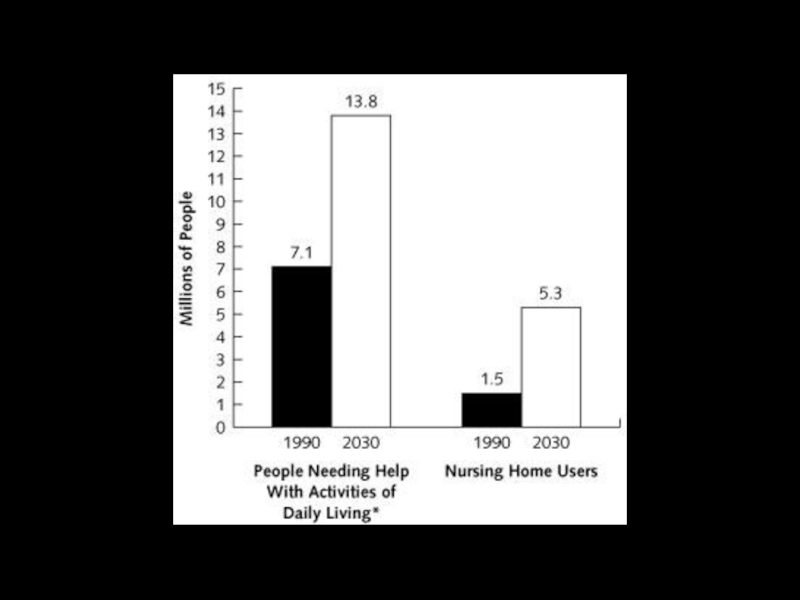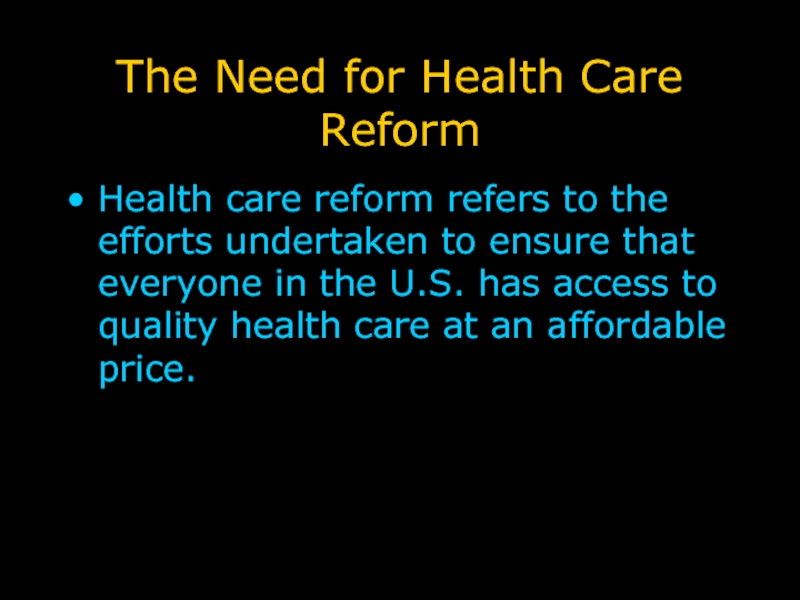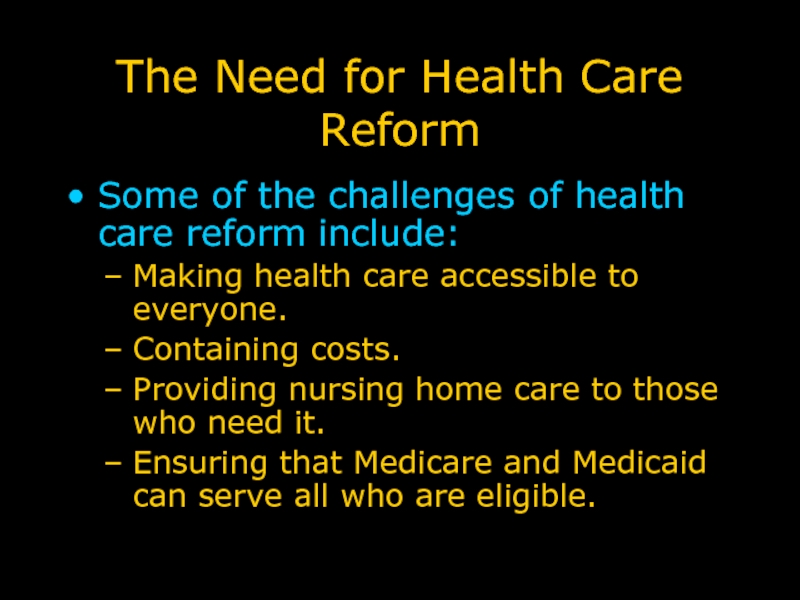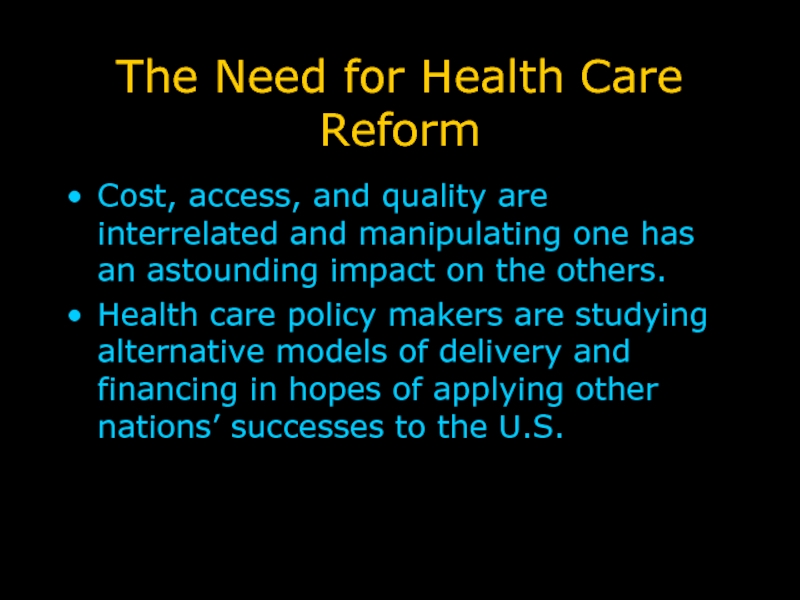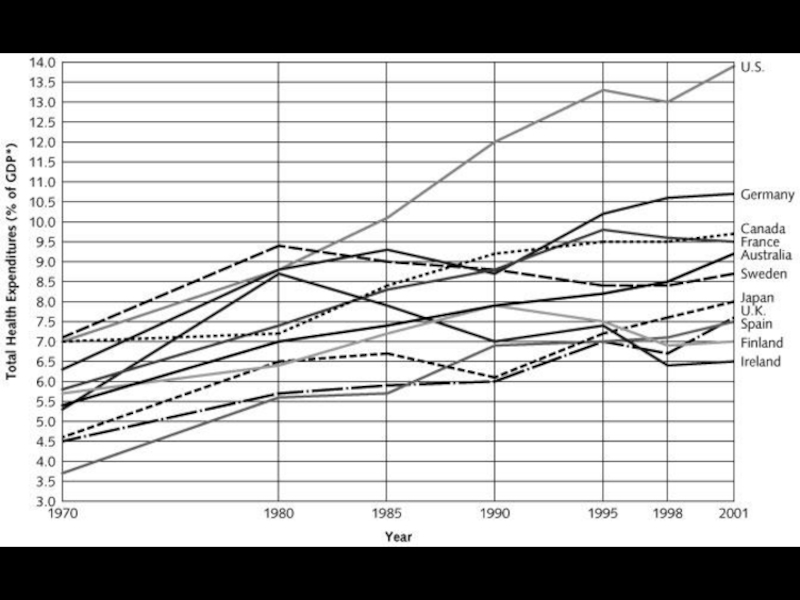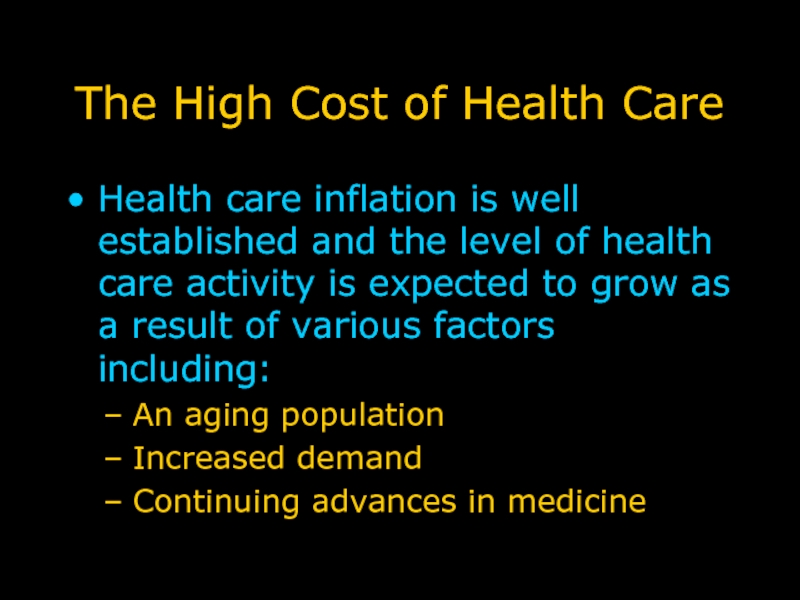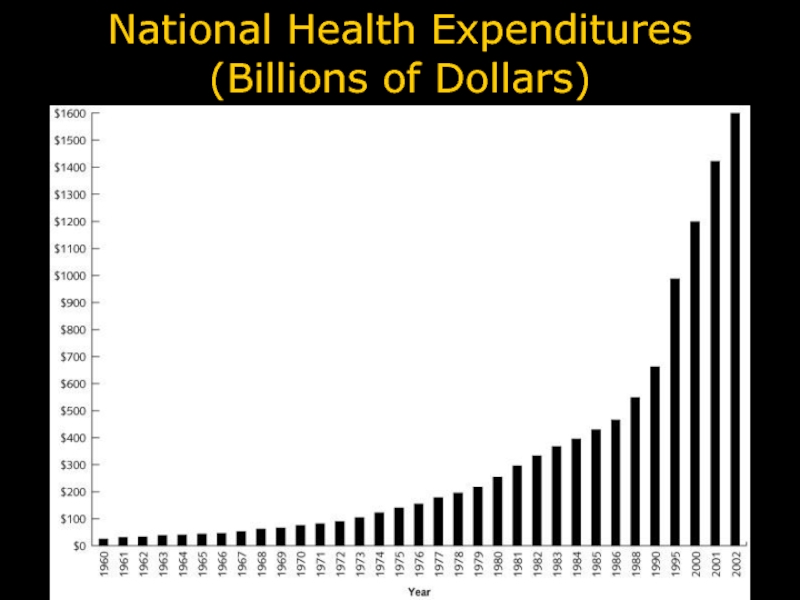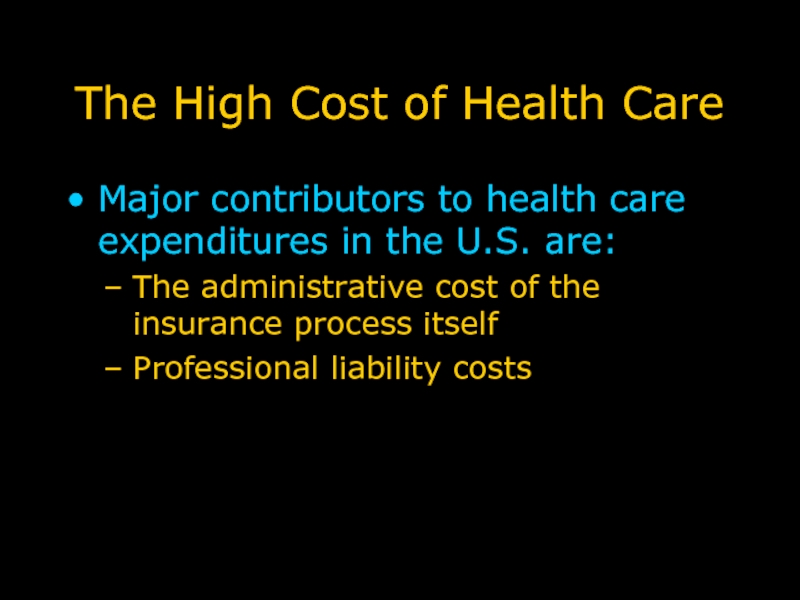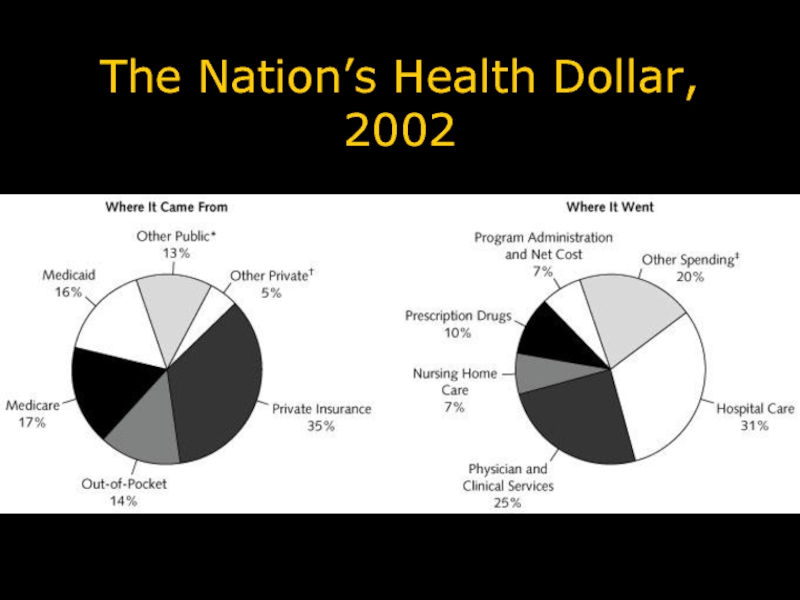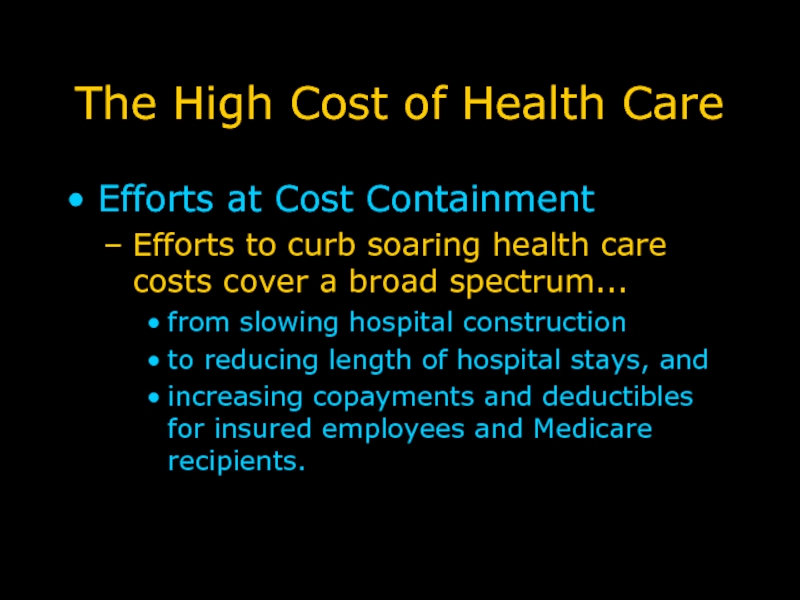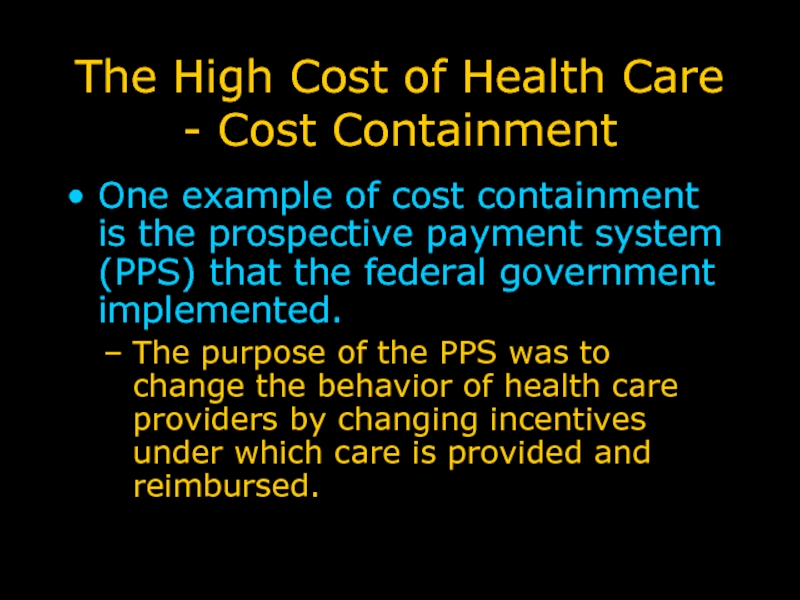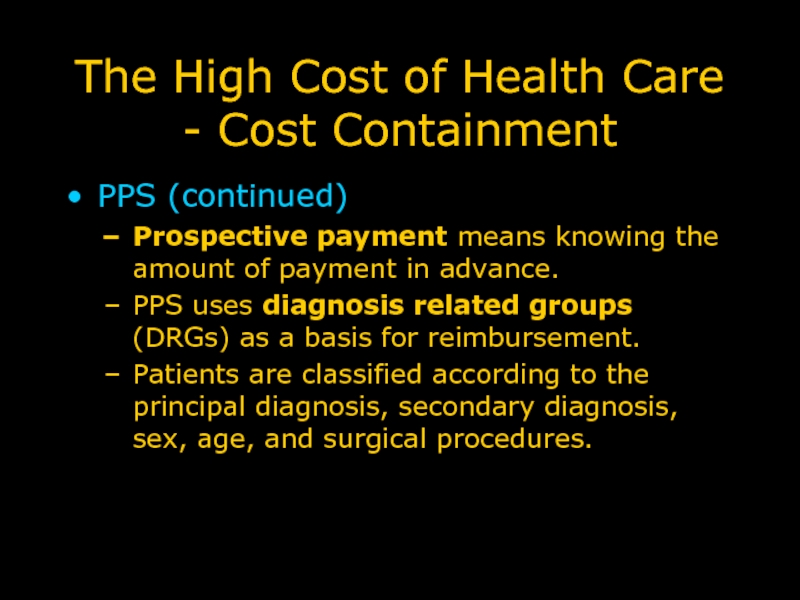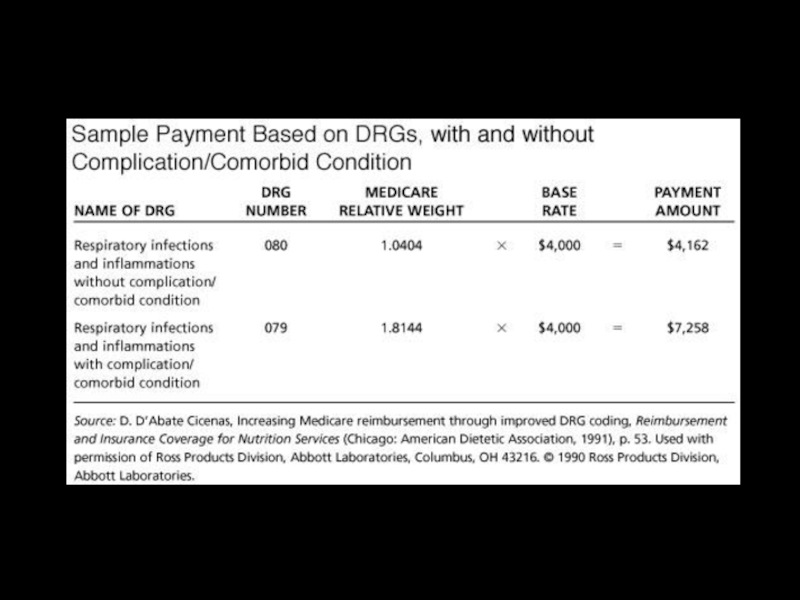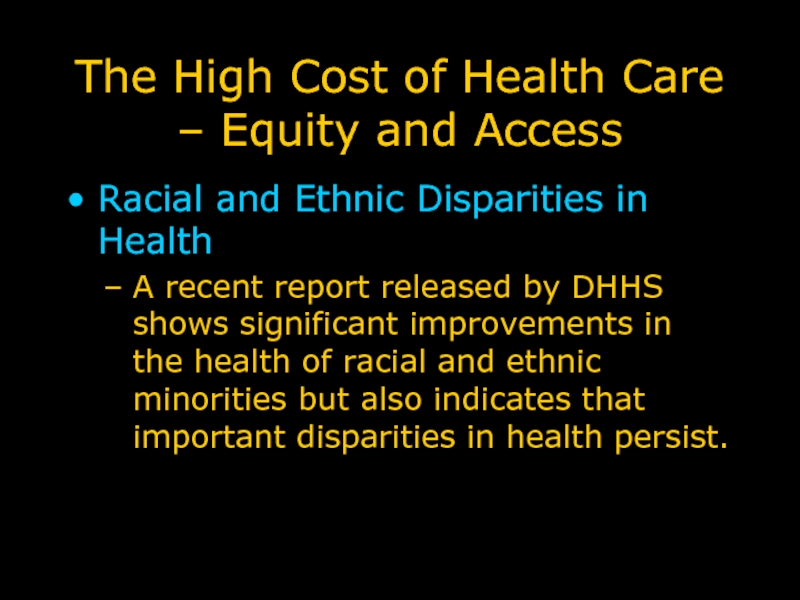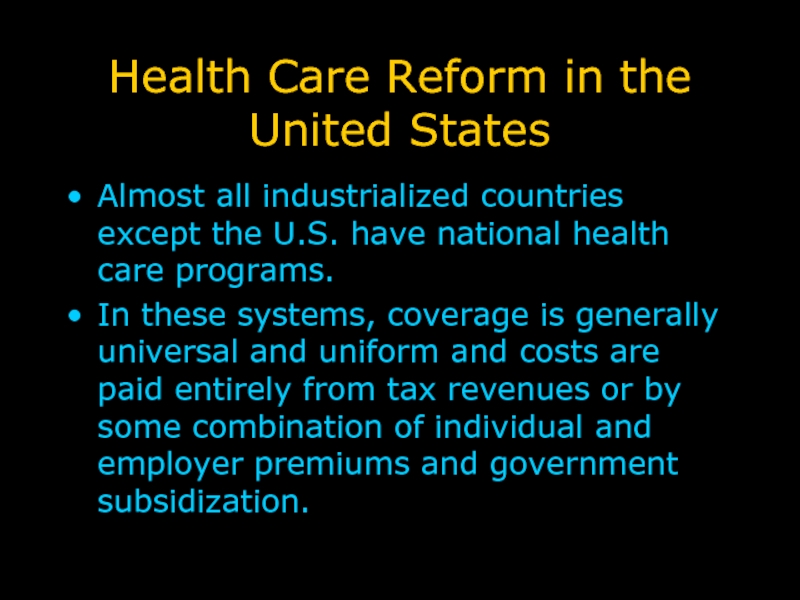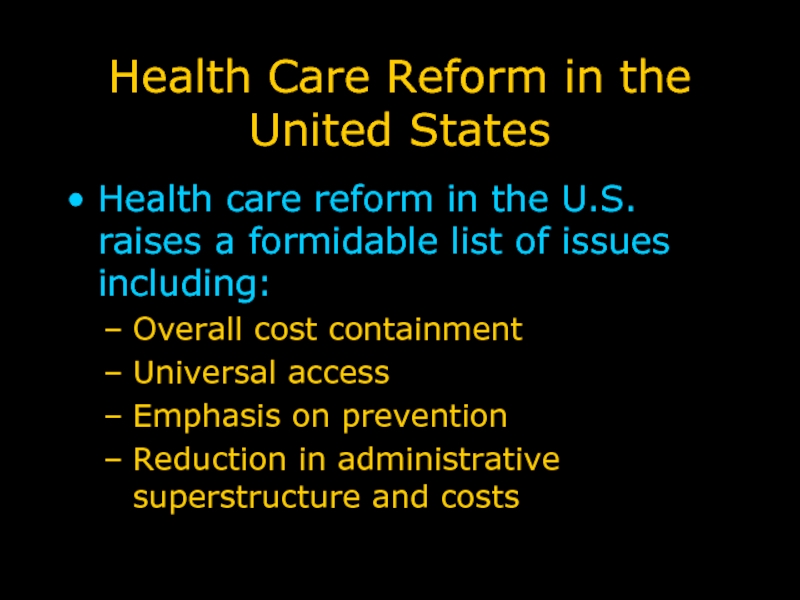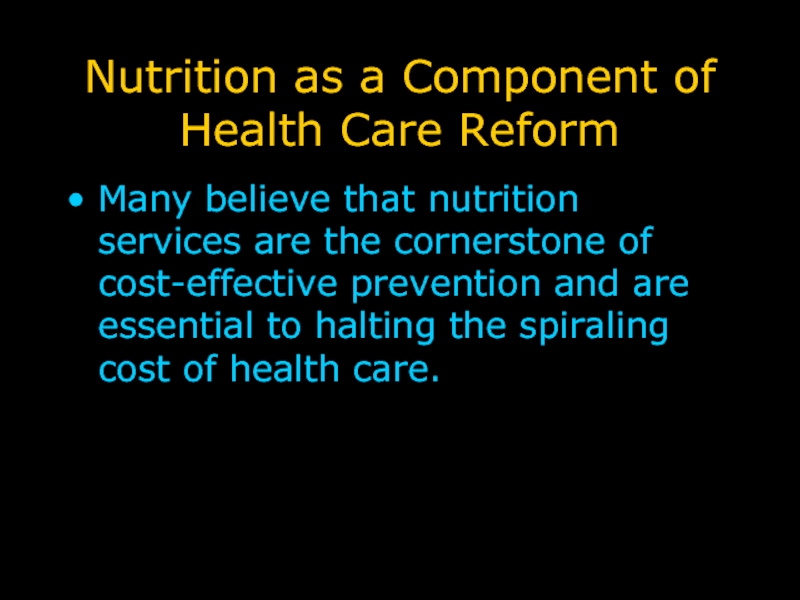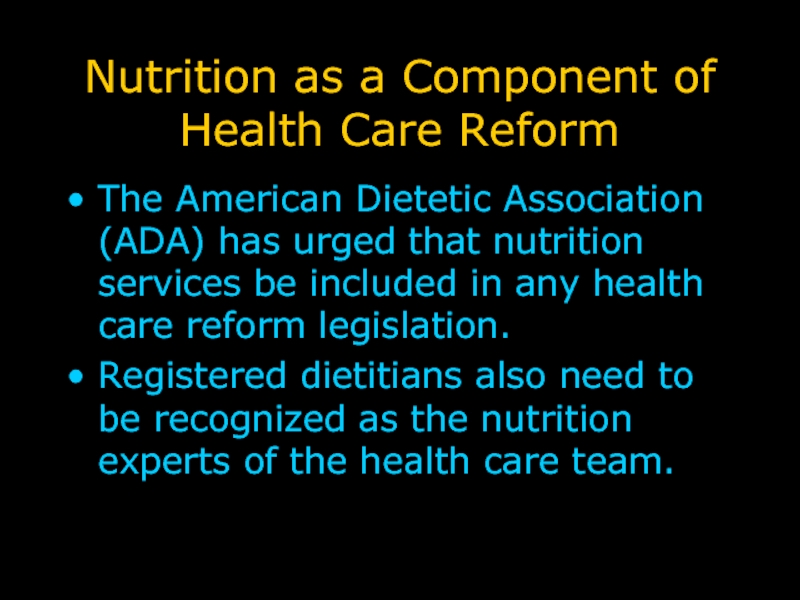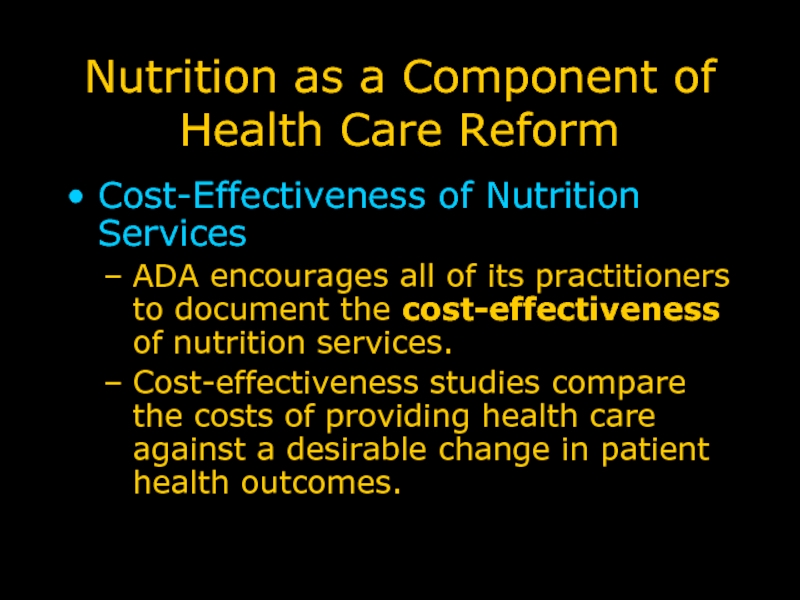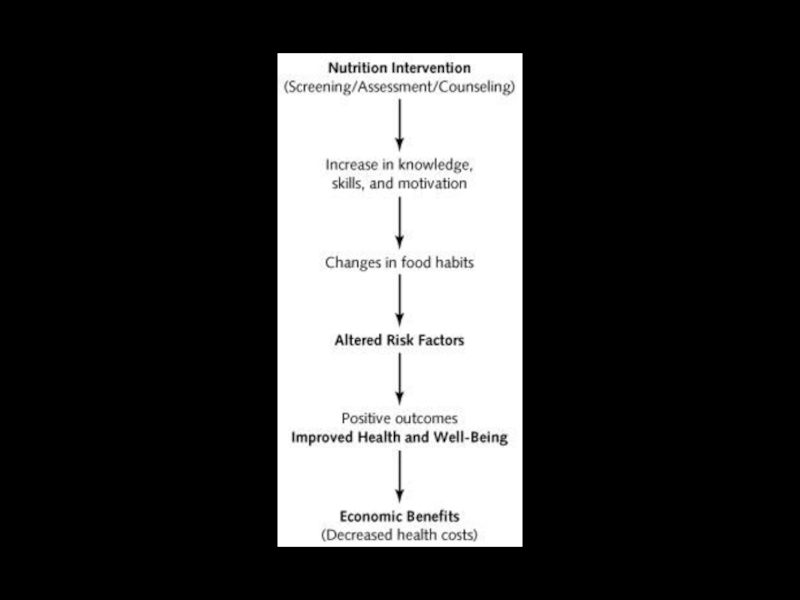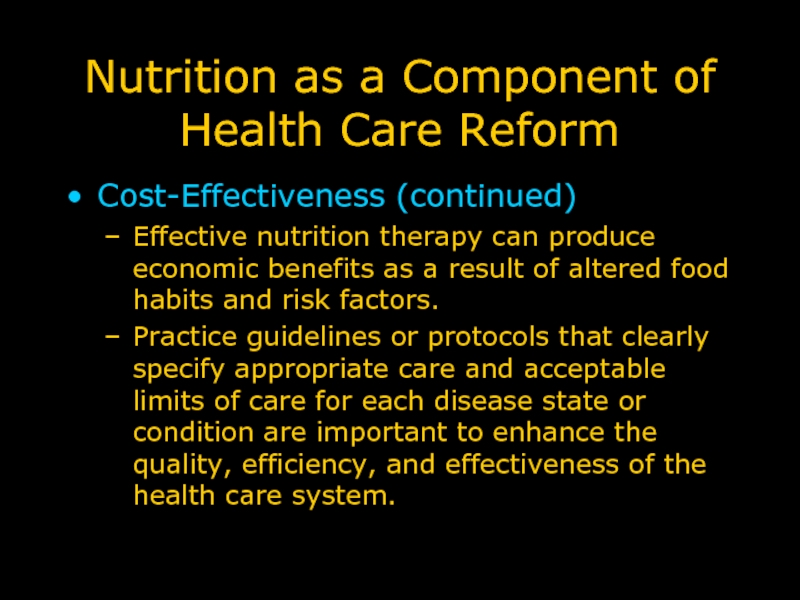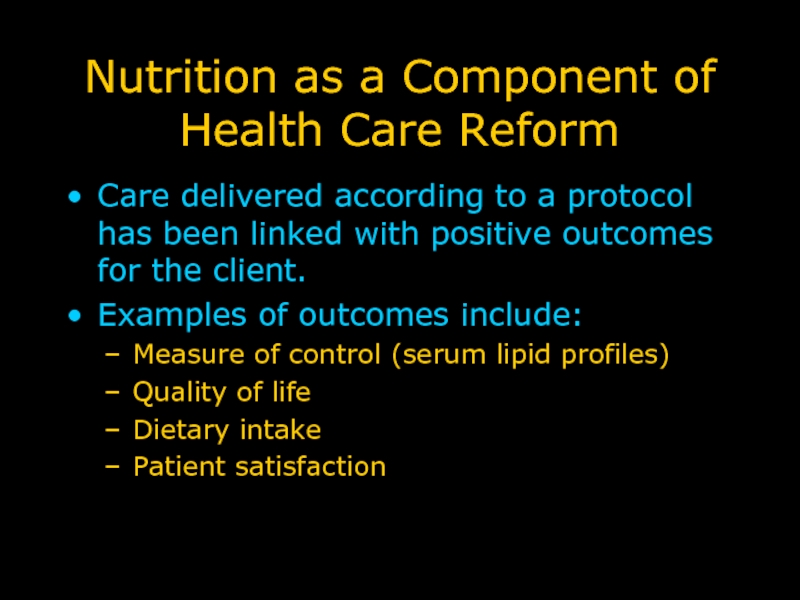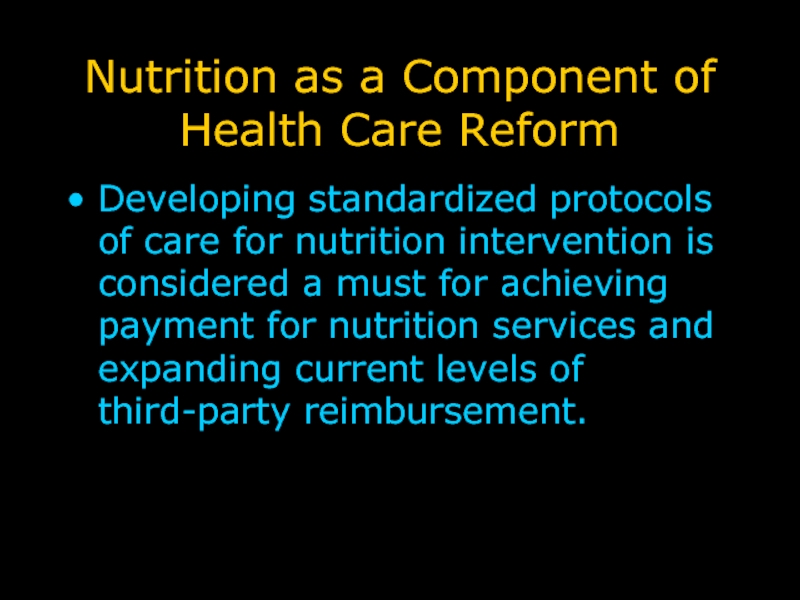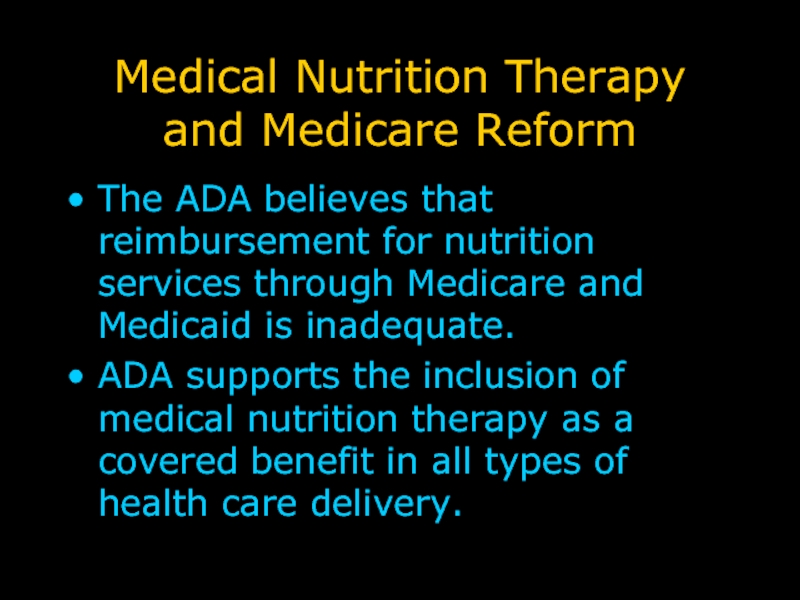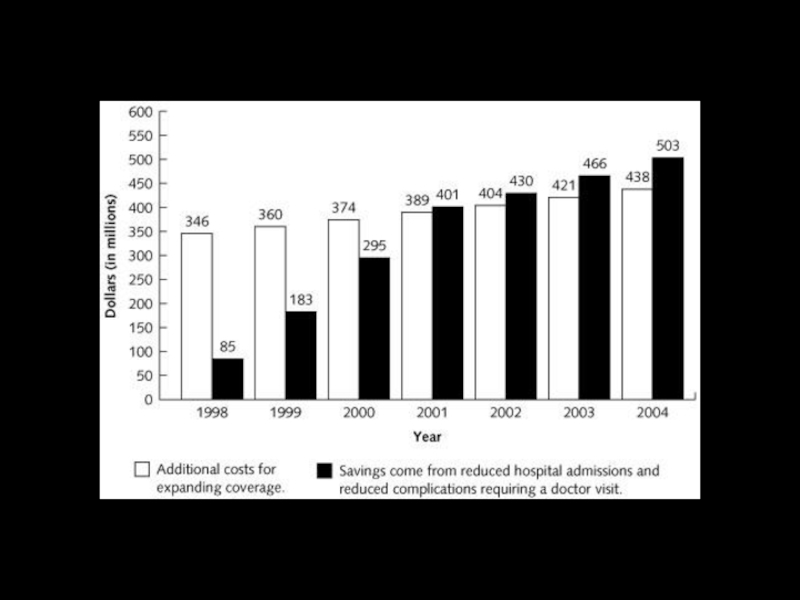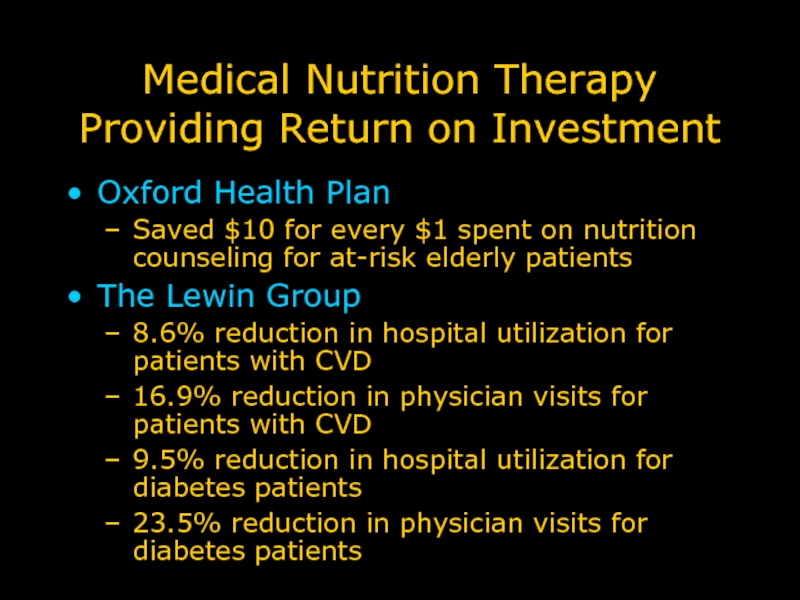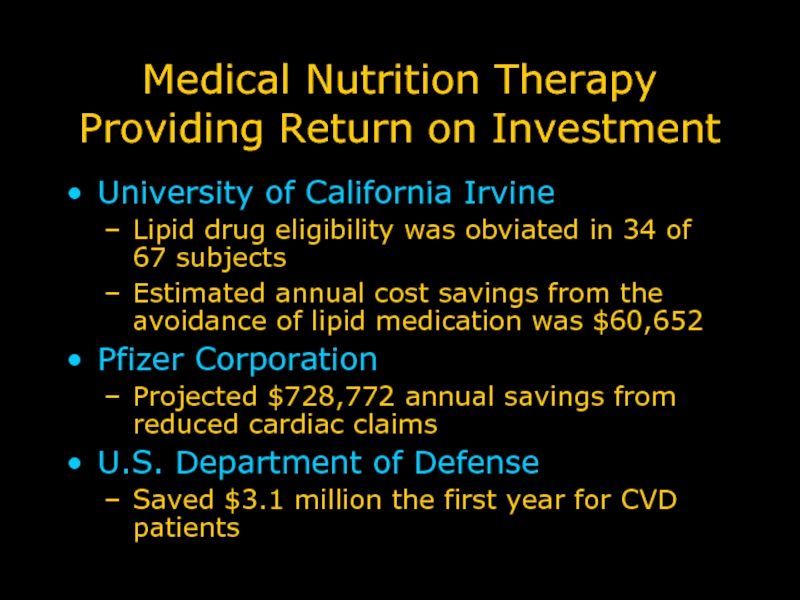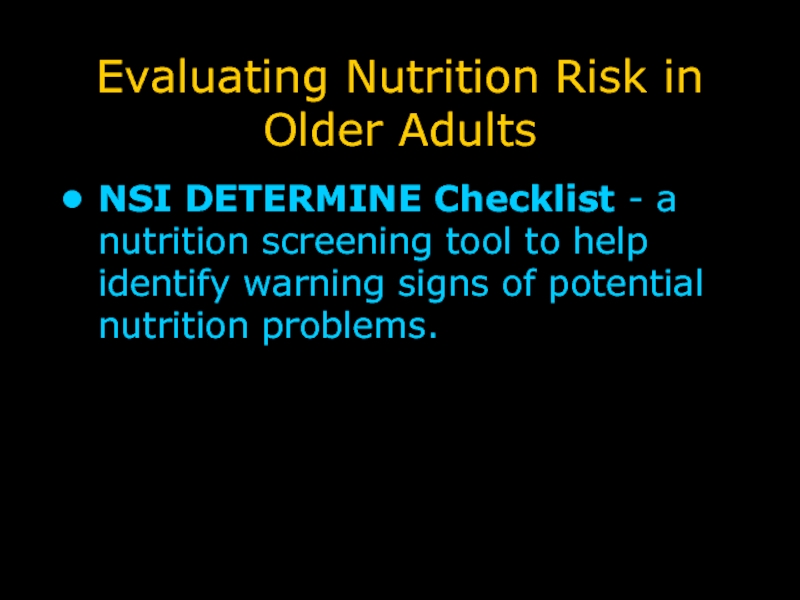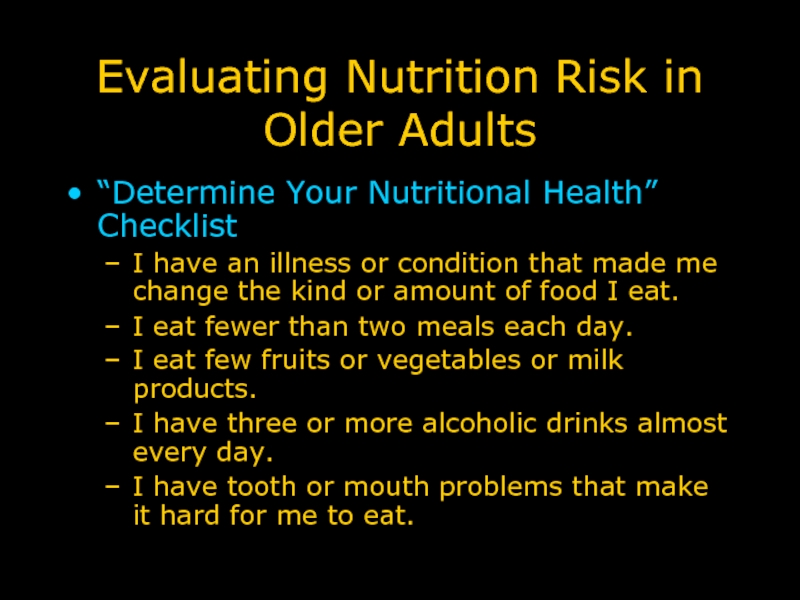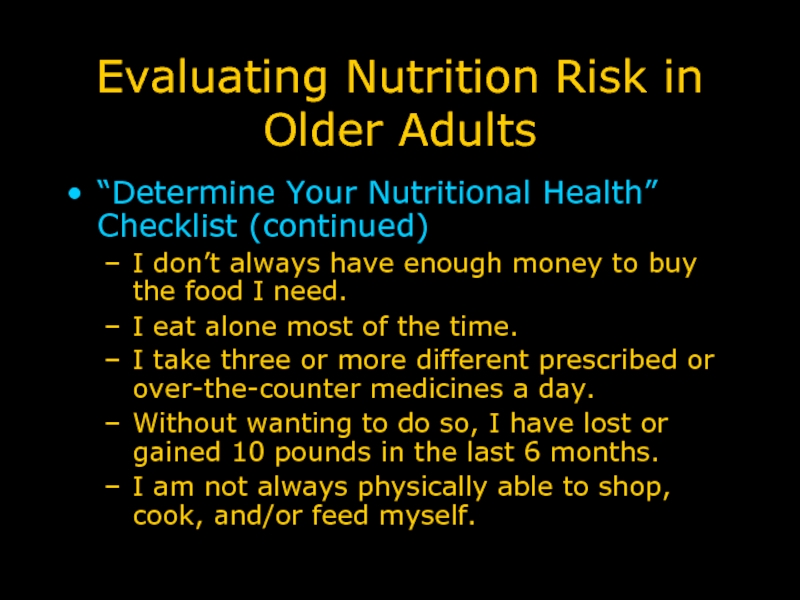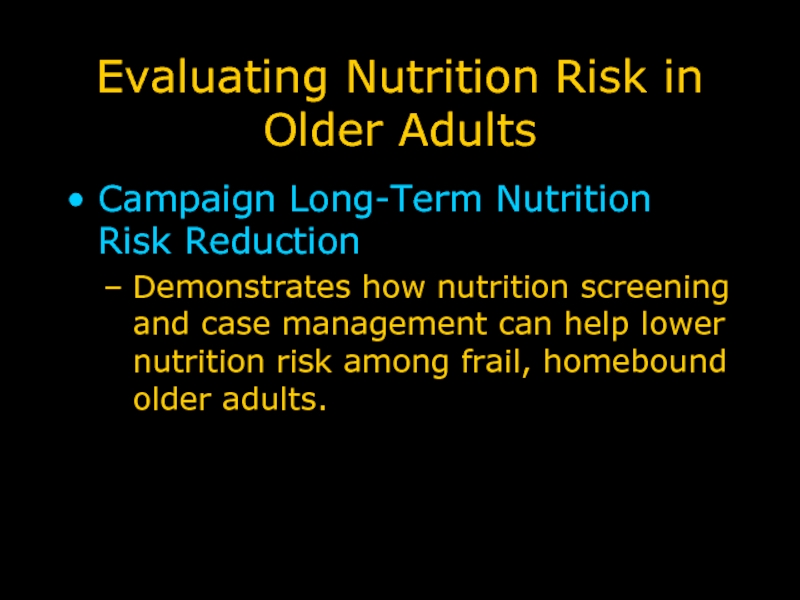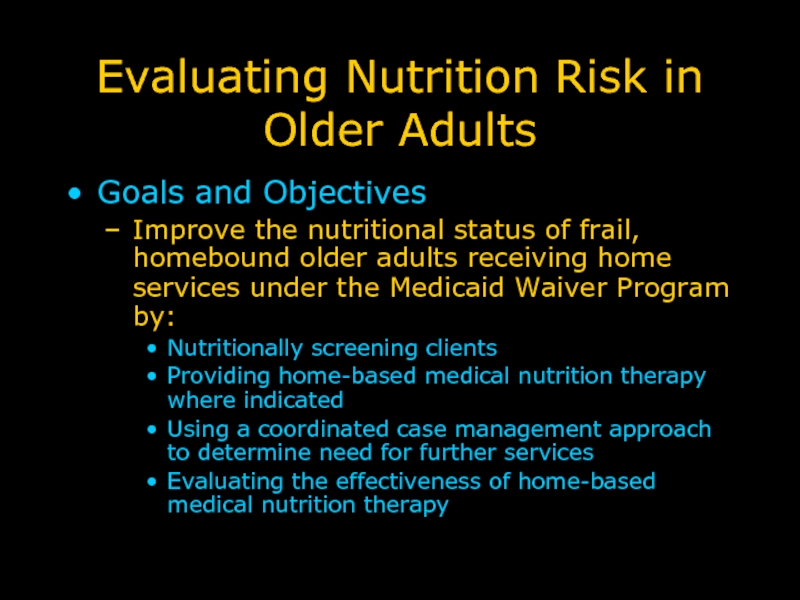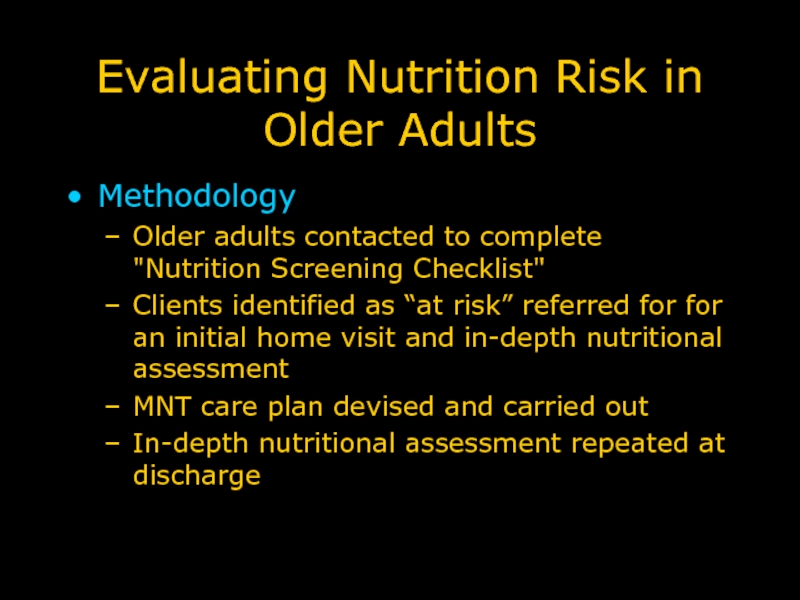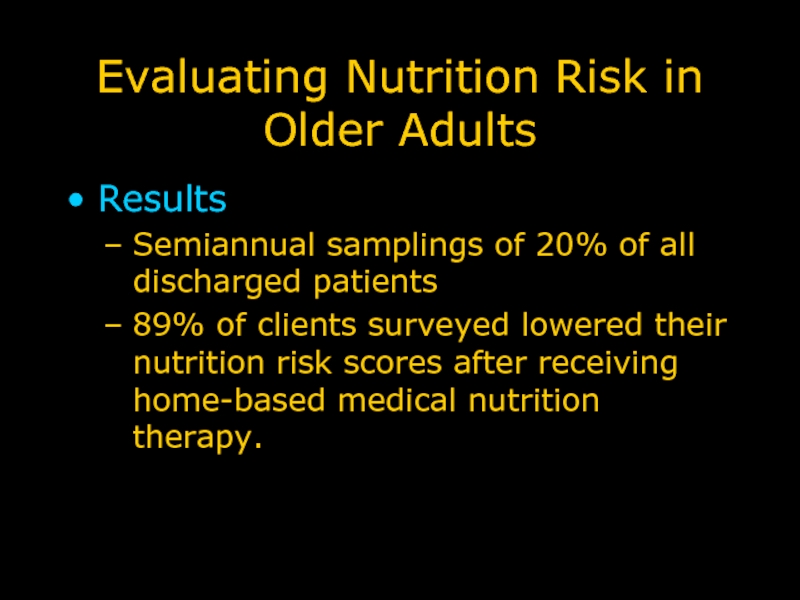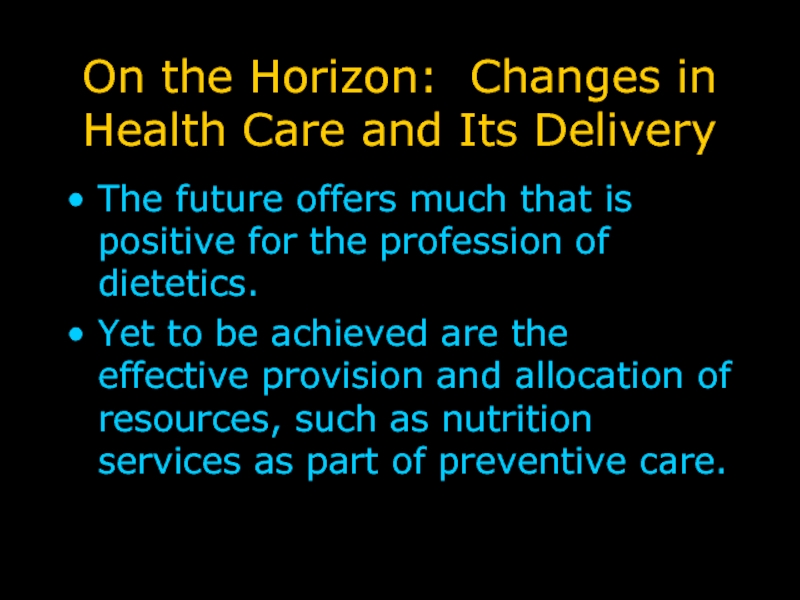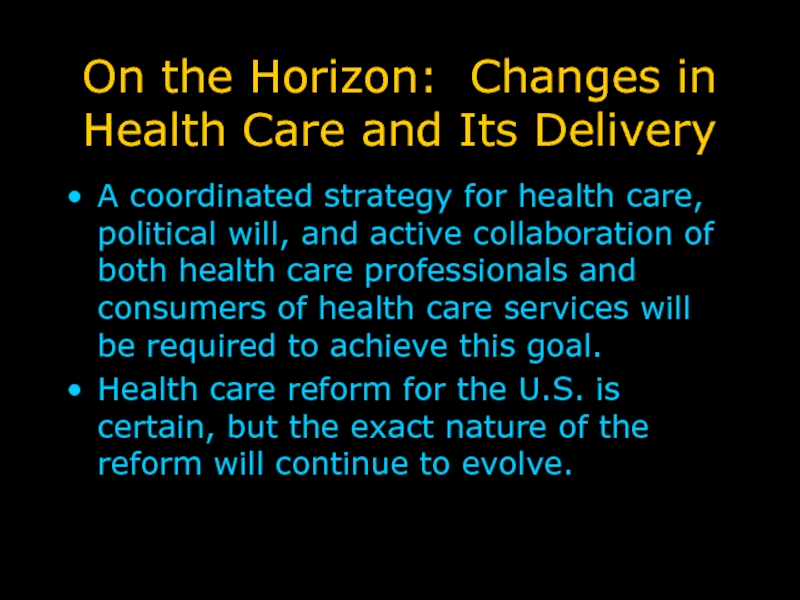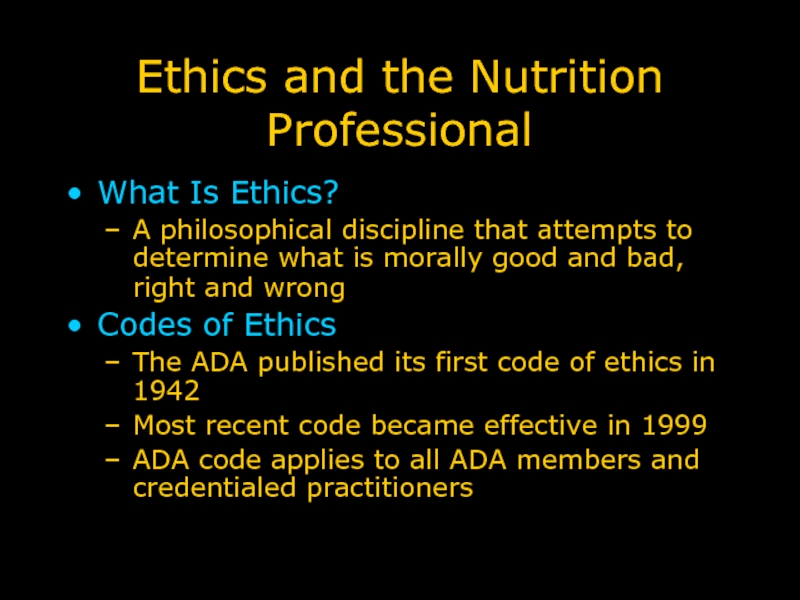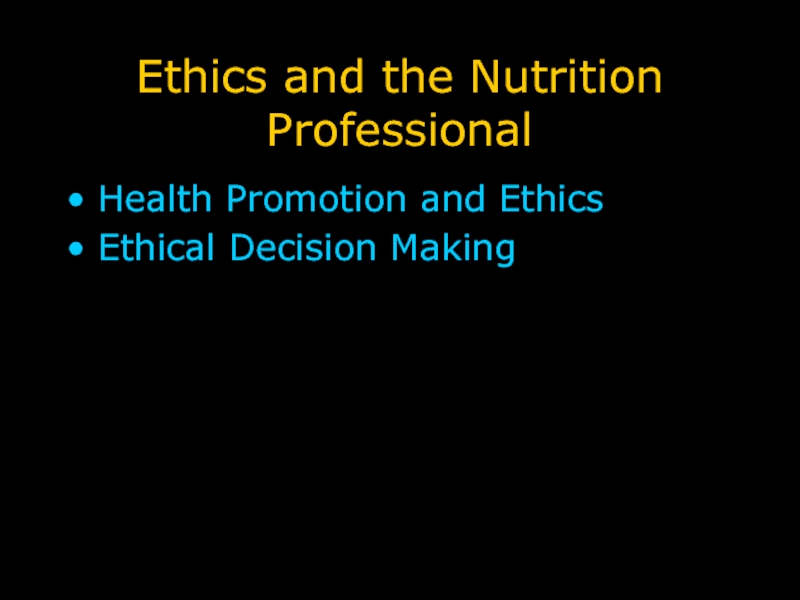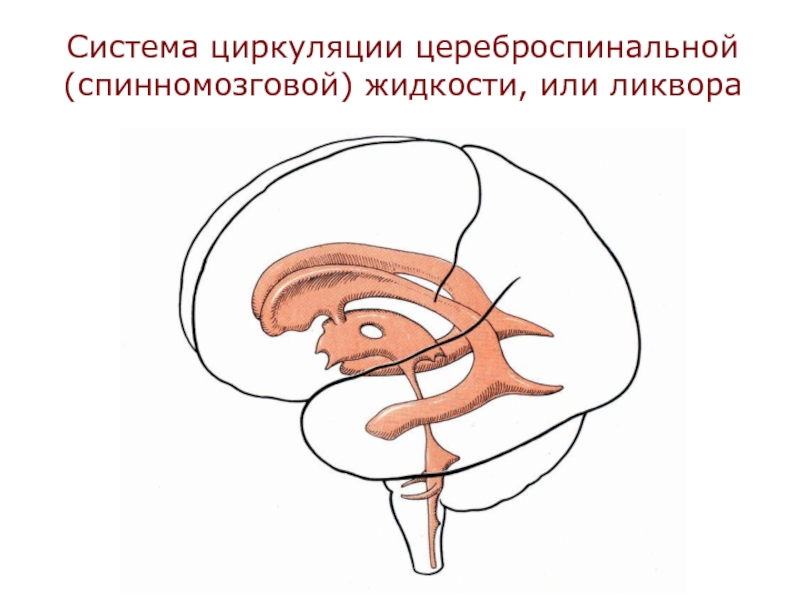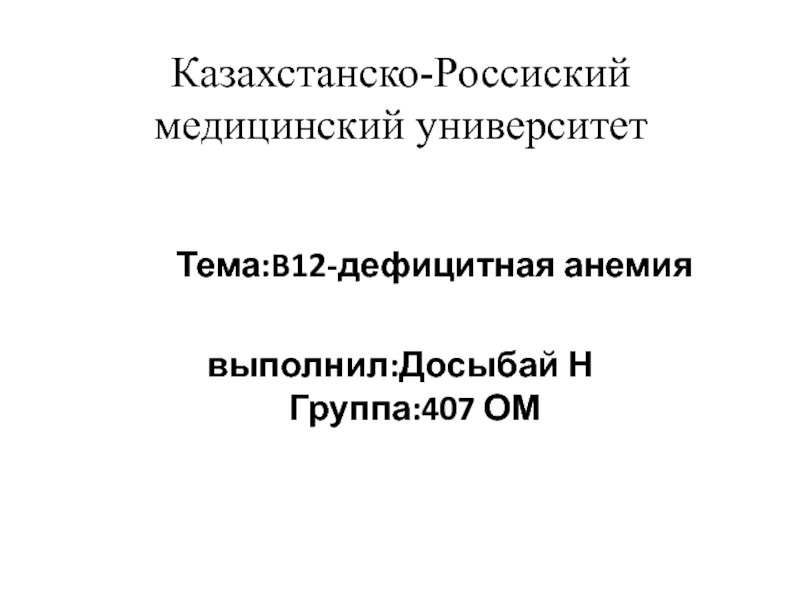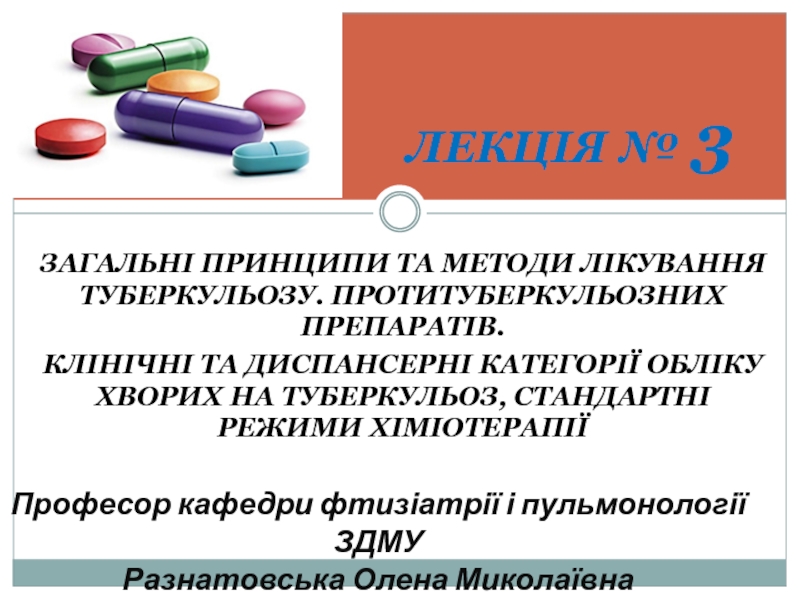- Главная
- Разное
- Дизайн
- Бизнес и предпринимательство
- Аналитика
- Образование
- Развлечения
- Красота и здоровье
- Финансы
- Государство
- Путешествия
- Спорт
- Недвижимость
- Армия
- Графика
- Культурология
- Еда и кулинария
- Лингвистика
- Английский язык
- Астрономия
- Алгебра
- Биология
- География
- Детские презентации
- Информатика
- История
- Литература
- Маркетинг
- Математика
- Медицина
- Менеджмент
- Музыка
- МХК
- Немецкий язык
- ОБЖ
- Обществознание
- Окружающий мир
- Педагогика
- Русский язык
- Технология
- Физика
- Философия
- Химия
- Шаблоны, картинки для презентаций
- Экология
- Экономика
- Юриспруденция
Health care systems and policy. (Chapter 9) презентация
Содержание
- 1. Health care systems and policy. (Chapter 9)
- 2. © 2006 Thomson-Wadsworth Learning Objectives Describe factors
- 3. © 2006 Thomson-Wadsworth Learning Objectives Describe eligibility
- 4. © 2006 Thomson-Wadsworth Introduction In 2000, Americans
- 5. © 2006 Thomson-Wadsworth Introduction Public policy is
- 6. © 2006 Thomson-Wadsworth An Overview of the
- 7. © 2006 Thomson-Wadsworth
- 8. © 2006 Thomson-Wadsworth Private Insurance Approximately 70.2%
- 9. © 2006 Thomson-Wadsworth Private Insurance Traditional Fee-for-Service
- 10. © 2006 Thomson-Wadsworth Private Insurance Group Contract
- 11. © 2006 Thomson-Wadsworth
- 12. © 2006 Thomson-Wadsworth Private Insurance – Group
- 13. © 2006 Thomson-Wadsworth Private Insurance – Group
- 14. © 2006 Thomson-Wadsworth Private Insurance – Group
- 15. © 2006 Thomson-Wadsworth
- 16. © 2006 Thomson-Wadsworth Public Insurance Medicare and
- 17. © 2006 Thomson-Wadsworth
- 18. © 2006 Thomson-Wadsworth
- 19. © 2006 Thomson-Wadsworth The Medicare Program Medicare
- 20. © 2006 Thomson-Wadsworth The Medicare Program Medicare
- 21. © 2006 Thomson-Wadsworth The Medicare Program Medicare
- 22. © 2006 Thomson-Wadsworth The Medicare Program Medicare
- 23. © 2006 Thomson-Wadsworth The Medicare Program Coverage Gaps Medicare Modernization Act Medicare Advantage Plan
- 24. © 2006 Thomson-Wadsworth The Medicaid Program Medicaid
- 25. © 2006 Thomson-Wadsworth The Medicaid Program The
- 26. © 2006 Thomson-Wadsworth The Medicaid Program Medicaid
- 27. © 2006 Thomson-Wadsworth The State Children’s Health
- 28. © 2006 Thomson-Wadsworth SCHIP Enrollment, 1999-2003
- 29. © 2006 Thomson-Wadsworth The Uninsured The uninsured
- 30. © 2006 Thomson-Wadsworth The Uninsured The non-working
- 31. © 2006 Thomson-Wadsworth % of U.S. Persons without Health Care Coverage, 2003
- 32. © 2006 Thomson-Wadsworth Demographic Trends and Health
- 33. © 2006 Thomson-Wadsworth
- 34. © 2006 Thomson-Wadsworth The Need for Health
- 35. © 2006 Thomson-Wadsworth The Need for Health
- 36. © 2006 Thomson-Wadsworth The Need for Health
- 37. © 2006 Thomson-Wadsworth
- 38. © 2006 Thomson-Wadsworth The High Cost of
- 39. © 2006 Thomson-Wadsworth National Health Expenditures (Billions of Dollars)
- 40. © 2006 Thomson-Wadsworth The High Cost of
- 41. © 2006 Thomson-Wadsworth The Nation’s Health Dollar, 2002
- 42. © 2006 Thomson-Wadsworth The High Cost of
- 43. © 2006 Thomson-Wadsworth The High Cost of
- 44. © 2006 Thomson-Wadsworth The High Cost of
- 45. © 2006 Thomson-Wadsworth
- 46. © 2006 Thomson-Wadsworth The High Cost of
- 47. © 2006 Thomson-Wadsworth The High Cost of
- 48. © 2006 Thomson-Wadsworth The High Cost of
- 49. © 2006 Thomson-Wadsworth Health Care Reform in
- 50. © 2006 Thomson-Wadsworth Health Care Reform in
- 51. © 2006 Thomson-Wadsworth Health Care Reform in
- 52. © 2006 Thomson-Wadsworth Nutrition as a Component
- 53. © 2006 Thomson-Wadsworth Nutrition as a Component
- 54. © 2006 Thomson-Wadsworth Nutrition as a Component
- 55. © 2006 Thomson-Wadsworth
- 56. © 2006 Thomson-Wadsworth Nutrition as a Component
- 57. © 2006 Thomson-Wadsworth Nutrition as a Component
- 58. © 2006 Thomson-Wadsworth Measurable Outcomes of Nutrition Intervention
- 59. © 2006 Thomson-Wadsworth Nutrition as a Component
- 60. © 2006 Thomson-Wadsworth Medical Nutrition Therapy and
- 61. © 2006 Thomson-Wadsworth
- 62. © 2006 Thomson-Wadsworth Medical Nutrition Therapy Providing
- 63. © 2006 Thomson-Wadsworth Medical Nutrition Therapy Providing
- 64. © 2006 Thomson-Wadsworth Evaluating Nutrition Risk in
- 65. © 2006 Thomson-Wadsworth Evaluating Nutrition Risk in
- 66. © 2006 Thomson-Wadsworth Evaluating Nutrition Risk in
- 67. © 2006 Thomson-Wadsworth Evaluating Nutrition Risk in
- 68. © 2006 Thomson-Wadsworth Evaluating Nutrition Risk in
- 69. © 2006 Thomson-Wadsworth Evaluating Nutrition Risk in
- 70. © 2006 Thomson-Wadsworth Evaluating Nutrition Risk in
- 71. © 2006 Thomson-Wadsworth On the Horizon: Changes
- 72. © 2006 Thomson-Wadsworth On the Horizon: Changes
- 73. © 2006 Thomson-Wadsworth Ethics and the Nutrition
- 74. © 2006 Thomson-Wadsworth Ethics and the Nutrition
- 75. © 2006 Thomson-Wadsworth Ethics and the Nutrition Professional Health Promotion and Ethics Ethical Decision Making
Слайд 2© 2006 Thomson-Wadsworth
Learning Objectives
Describe factors affecting the cost and delivery of
Explain why health promotion is a major component of the rhetoric about health care reform at the national level.
Differentiate between traditional systems of health care and managed forms of health care.
Слайд 3© 2006 Thomson-Wadsworth
Learning Objectives
Describe eligibility requirements for and services provided to
Identify consumer trends affecting health care.
State the value of using medical nutrition therapy protocols to document client outcomes in various health care settings.
Слайд 4© 2006 Thomson-Wadsworth
Introduction
In 2000, Americans spent more than $1.2 trillion for
This amount exceeds the average amount spent by any other industrialized country.
Слайд 5© 2006 Thomson-Wadsworth
Introduction
Public policy is attempting to direct our medical system
Many studies show that early detection and intervention, immunization, and behavior change could significantly reduce many of the leading causes of death and disability.
Слайд 6© 2006 Thomson-Wadsworth
An Overview of the Health Care Industry
Two general categories
Private
Traditional fee-for-service
Group contract
Public
Medicare
Medicaid
State Children’s Health Insurance Program
Слайд 8© 2006 Thomson-Wadsworth
Private Insurance
Approximately 70.2% of Americans have private insurance.
Private insurance
Слайд 9© 2006 Thomson-Wadsworth
Private Insurance
Traditional Fee-for-Service Plans
Include a billing system in which
Critics of this plan claim that they encourage physicians to provide more services than necessary.
Proponents prefer the greater flexibility and unrestricted access to physicians, tests, hospitals, and treatments.
Слайд 10© 2006 Thomson-Wadsworth
Private Insurance
Group Contract Insurance
Managed-care systems, represented by health maintenance
The goal of managed care is improved quality of care with decreased cost.
91% of employees with health insurance were enrolled in managed-care plans in 1999.
Слайд 12© 2006 Thomson-Wadsworth
Private Insurance – Group Contract Insurance
HMOs provide comprehensive services
Prepaid group health plans emphasize health promotion since they provide health care services at a preset cost.
By keeping people healthy, HMOs avoid lengthy hospitalizations and costly services.
Слайд 13© 2006 Thomson-Wadsworth
Private Insurance – Group Contract Insurance
General HMO models:
Staff model
Group
Network model
Independent practice association (IPA)
Point-of-service (POS) plan
Слайд 14© 2006 Thomson-Wadsworth
Private Insurance – Group Contract Insurance
In some HMOs, provider
Capitation payment – A predetermined fee paid per enrollee per month to the provider
Слайд 16© 2006 Thomson-Wadsworth
Public Insurance
Medicare and Medicaid - administered by the Centers
State Children’s Health Insurance Program
Слайд 19© 2006 Thomson-Wadsworth
The Medicare Program
Medicare is the largest health care insurer
It is designed to assist:
People 65 and older
People of any age with end-stage renal disease
People eligible for Social Security disability payment programs for more than 2 years
Qualified railroad retirement beneficiaries and merchant seamen
Слайд 20© 2006 Thomson-Wadsworth
The Medicare Program
Medicare consists of two separate parts:
Hospital
Medical insurance (Part B)
Слайд 21© 2006 Thomson-Wadsworth
The Medicare Program
Medicare Part A
Provides hospital insurance benefits
Hospital inpatient charges are reimbursed according to prospective payment system known as diagnosis related groups (DRGs).
Слайд 22© 2006 Thomson-Wadsworth
The Medicare Program
Medicare Part B
An optional insurance program
Enrolled Medicare Medical Nutrition Therapy (MNT) providers are able to bill Medicare for MNT services provided to beneficiaries with type 1, type 2, and gestational diabetes, nondialysis kidney disease, and post-kidney transplants.
Слайд 23© 2006 Thomson-Wadsworth
The Medicare Program
Coverage Gaps
Medicare Modernization Act
Medicare Advantage Plan
Слайд 24© 2006 Thomson-Wadsworth
The Medicaid Program
Medicaid is a joint state and federal
Eligible, low-income persons
Certain low-income pregnant women and children
The aged, blind, and people with disabilities
Members of families with dependent children in which one parent is absent, incapacitated, or unemployed
Слайд 25© 2006 Thomson-Wadsworth
The Medicaid Program
The individual states define eligibility, benefits, and
Typically, one must meet three criteria, including income, categorical, and resource.
Слайд 26© 2006 Thomson-Wadsworth
The Medicaid Program
Medicaid covers a variety of services and
To date, 36 state Medicaid programs cover certain forms of nutrition services provided by dietitians.
Слайд 27© 2006 Thomson-Wadsworth
The State Children’s Health Insurance Program
The State Children’s Health
States have flexibility in targeting eligible uninsured children.
Many of the children served come from working families with incomes too high to qualify for Medicaid but too low to afford private health insurance.
Слайд 29© 2006 Thomson-Wadsworth
The Uninsured
The uninsured include the working poor and those
The employed uninsured number 15 million.
Слайд 30© 2006 Thomson-Wadsworth
The Uninsured
The non-working uninsured number 9 million and include:
The homeless
Some deinstitutionalized mentally ill patients
Low-income people who do not qualify for Medicaid
Слайд 32© 2006 Thomson-Wadsworth
Demographic Trends and Health Care
By the year 2030, the
Racial and geographical factors in the population are also important to the shape of the future.
Слайд 34© 2006 Thomson-Wadsworth
The Need for Health Care Reform
Health care reform refers
Слайд 35© 2006 Thomson-Wadsworth
The Need for Health Care Reform
Some of the challenges
Making health care accessible to everyone.
Containing costs.
Providing nursing home care to those who need it.
Ensuring that Medicare and Medicaid can serve all who are eligible.
Слайд 36© 2006 Thomson-Wadsworth
The Need for Health Care Reform
Cost, access, and quality
Health care policy makers are studying alternative models of delivery and financing in hopes of applying other nations’ successes to the U.S.
Слайд 38© 2006 Thomson-Wadsworth
The High Cost of Health Care
Health care inflation is
An aging population
Increased demand
Continuing advances in medicine
Слайд 40© 2006 Thomson-Wadsworth
The High Cost of Health Care
Major contributors to health
The administrative cost of the insurance process itself
Professional liability costs
Слайд 42© 2006 Thomson-Wadsworth
The High Cost of Health Care
Efforts at Cost Containment
Efforts
from slowing hospital construction
to reducing length of hospital stays, and
increasing copayments and deductibles for insured employees and Medicare recipients.
Слайд 43© 2006 Thomson-Wadsworth
The High Cost of Health Care - Cost Containment
One
The purpose of the PPS was to change the behavior of health care providers by changing incentives under which care is provided and reimbursed.
Слайд 44© 2006 Thomson-Wadsworth
The High Cost of Health Care - Cost Containment
PPS
Prospective payment means knowing the amount of payment in advance.
PPS uses diagnosis related groups (DRGs) as a basis for reimbursement.
Patients are classified according to the principal diagnosis, secondary diagnosis, sex, age, and surgical procedures.
Слайд 46© 2006 Thomson-Wadsworth
The High Cost of Health Care - Cost Containment
PPS
There are 23 categories and a total of 490 DRGs.
One consequence of PPS has been an increased focus on outpatient services.
Слайд 47© 2006 Thomson-Wadsworth
The High Cost of Health Care
Equity and Access as
Public opinion polls in the U.S. reveal that most people believe all citizens are entitled to access to health care...
but debate continues about the acceptable level of health care and what benefits should be included.
Слайд 48© 2006 Thomson-Wadsworth
The High Cost of Health Care – Equity and
Racial and Ethnic Disparities in Health
A recent report released by DHHS shows significant improvements in the health of racial and ethnic minorities but also indicates that important disparities in health persist.
Слайд 49© 2006 Thomson-Wadsworth
Health Care Reform in the United States
Almost all industrialized
In these systems, coverage is generally universal and uniform and costs are paid entirely from tax revenues or by some combination of individual and employer premiums and government subsidization.
Слайд 50© 2006 Thomson-Wadsworth
Health Care Reform in the United States
Health care reform
Overall cost containment
Universal access
Emphasis on prevention
Reduction in administrative superstructure and costs
Слайд 51© 2006 Thomson-Wadsworth
Health Care Reform in the United States
While the government
Слайд 52© 2006 Thomson-Wadsworth
Nutrition as a Component of Health Care Reform
Many believe
Слайд 53© 2006 Thomson-Wadsworth
Nutrition as a Component of Health Care Reform
The American
Registered dietitians also need to be recognized as the nutrition experts of the health care team.
Слайд 54© 2006 Thomson-Wadsworth
Nutrition as a Component of Health Care Reform
Cost-Effectiveness of
ADA encourages all of its practitioners to document the cost-effectiveness of nutrition services.
Cost-effectiveness studies compare the costs of providing health care against a desirable change in patient health outcomes.
Слайд 56© 2006 Thomson-Wadsworth
Nutrition as a Component of Health Care Reform
Cost-Effectiveness (continued)
Effective
Practice guidelines or protocols that clearly specify appropriate care and acceptable limits of care for each disease state or condition are important to enhance the quality, efficiency, and effectiveness of the health care system.
Слайд 57© 2006 Thomson-Wadsworth
Nutrition as a Component of Health Care Reform
Care delivered
Examples of outcomes include:
Measure of control (serum lipid profiles)
Quality of life
Dietary intake
Patient satisfaction
Слайд 59© 2006 Thomson-Wadsworth
Nutrition as a Component of Health Care Reform
Developing standardized
Слайд 60© 2006 Thomson-Wadsworth
Medical Nutrition Therapy and Medicare Reform
The ADA believes that
ADA supports the inclusion of medical nutrition therapy as a covered benefit in all types of health care delivery.
Слайд 62© 2006 Thomson-Wadsworth
Medical Nutrition Therapy Providing Return on Investment
Oxford Health Plan
Saved $10 for every $1 spent on nutrition counseling for at-risk elderly patients
The Lewin Group
8.6% reduction in hospital utilization for patients with CVD
16.9% reduction in physician visits for patients with CVD
9.5% reduction in hospital utilization for diabetes patients
23.5% reduction in physician visits for diabetes patients
Слайд 63© 2006 Thomson-Wadsworth
Medical Nutrition Therapy Providing Return on Investment
University of California
Lipid drug eligibility was obviated in 34 of 67 subjects
Estimated annual cost savings from the avoidance of lipid medication was $60,652
Pfizer Corporation
Projected $728,772 annual savings from reduced cardiac claims
U.S. Department of Defense
Saved $3.1 million the first year for CVD patients
Слайд 64© 2006 Thomson-Wadsworth
Evaluating Nutrition Risk in Older Adults
NSI DETERMINE Checklist -
Слайд 65© 2006 Thomson-Wadsworth
Evaluating Nutrition Risk in Older Adults
“Determine Your Nutritional Health”
I have an illness or condition that made me change the kind or amount of food I eat.
I eat fewer than two meals each day.
I eat few fruits or vegetables or milk products.
I have three or more alcoholic drinks almost every day.
I have tooth or mouth problems that make it hard for me to eat.
Слайд 66© 2006 Thomson-Wadsworth
Evaluating Nutrition Risk in Older Adults
“Determine Your Nutritional Health”
I don’t always have enough money to buy the food I need.
I eat alone most of the time.
I take three or more different prescribed or over-the-counter medicines a day.
Without wanting to do so, I have lost or gained 10 pounds in the last 6 months.
I am not always physically able to shop, cook, and/or feed myself.
Слайд 67© 2006 Thomson-Wadsworth
Evaluating Nutrition Risk in Older Adults
Campaign Long-Term Nutrition Risk
Demonstrates how nutrition screening and case management can help lower nutrition risk among frail, homebound older adults.
Слайд 68© 2006 Thomson-Wadsworth
Evaluating Nutrition Risk in Older Adults
Goals and Objectives
Improve the
Nutritionally screening clients
Providing home-based medical nutrition therapy where indicated
Using a coordinated case management approach to determine need for further services
Evaluating the effectiveness of home-based medical nutrition therapy
Слайд 69© 2006 Thomson-Wadsworth
Evaluating Nutrition Risk in Older Adults
Methodology
Older adults contacted to
Clients identified as “at risk” referred for for an initial home visit and in-depth nutritional assessment
MNT care plan devised and carried out
In-depth nutritional assessment repeated at discharge
Слайд 70© 2006 Thomson-Wadsworth
Evaluating Nutrition Risk in Older Adults
Results
Semiannual samplings of 20%
89% of clients surveyed lowered their nutrition risk scores after receiving home-based medical nutrition therapy.
Слайд 71© 2006 Thomson-Wadsworth
On the Horizon: Changes in Health Care and Its
The future offers much that is positive for the profession of dietetics.
Yet to be achieved are the effective provision and allocation of resources, such as nutrition services as part of preventive care.
Слайд 72© 2006 Thomson-Wadsworth
On the Horizon: Changes in Health Care and Its
A coordinated strategy for health care, political will, and active collaboration of both health care professionals and consumers of health care services will be required to achieve this goal.
Health care reform for the U.S. is certain, but the exact nature of the reform will continue to evolve.
Слайд 73© 2006 Thomson-Wadsworth
Ethics and the Nutrition Professional
What Is Ethics?
A philosophical discipline
Codes of Ethics
The ADA published its first code of ethics in 1942
Most recent code became effective in 1999
ADA code applies to all ADA members and credentialed practitioners
Слайд 74© 2006 Thomson-Wadsworth
Ethics and the Nutrition Professional
Guiding Principles
Autonomy - respecting the
Beneficence - protecting clients from harm and maximizing possible benefits
Non-maleficence - the obligation not to inflict harm intentionally
Justice - striving for fairness in one’s actions and equality in the allocation of resources
